有源电力滤波器参考文献
有源电力滤波器英文文献和中文翻译
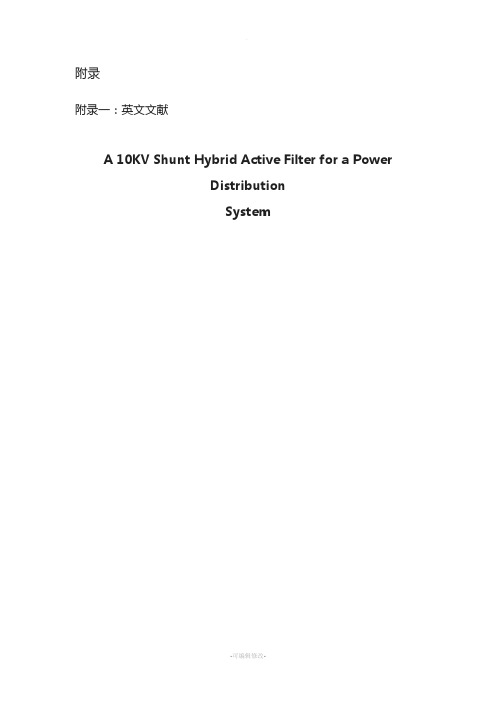
附录附录一:英文文献A 10KV Shunt Hybrid Active Filter for a PowerDistributionSystemAbstract—this paper analyzes the compensation performance of a shunt hybrid active power filter. The hybrid active power filter, which combines passive filter and active power filter, has both respective merits, and is an important developing trend of filtering device. The hybrid active power filter can reduce the capacity of active power filter effectively and is more suitable for the engineering application for high voltage nonlinear loads. The compensation performance of hybrid active power filter is analyzed by estimating the effect of different active power filter gain and parameters change. Then, a conclusion has been obtained that the harmonic attenuation rate is insensitive to the variation of passive parameters when the active power filter with an enough feedback gain is combined. Finally, the feasibility and validity of proposed scheme is verified by Simulation using Matlab and a hybrid shunt active power filter prototype.Index Terms:Current harmonics compensation, active power filter, passive filter, generalized integrators.I .INTRODUCTIONIn the development of power electronics brings convenience to energy conversion and utilization and also causes power quality problems. As one of the key technologies in combating power grid pollution and improving the power quality, active power filter (APF) has become a new research emphasis in power electronics technology[1]-[5].Because of high initial cost, the further application of active power filter is restricted. The HAPF(Hybrid Active Power Filter), combination of APF and passive filter (PF), can reduce the capacity of Affectively and is more suitable for the engineering application of APF for high voltage nonlinear loads.Traditionally, Passive filter has been used to eliminate the harmonic in power system due to his low cost and high efficiency. A passive filter shows the low impedance at tuned frequency to absorb current harmonic and has a good compensation performance. However, passive filter has the disadvantage of depending on the parameters of power system, susceptible to the load and power system resonant and the characteristic change due to aging. In addition, passive filter usually is designed with fixed parameters, which can not be lightly adapted for the variation operation condition.Active power filter has been developed to overcome of disadvantages of passive filter and can provide flexible and reliable compensation, but is not a cost-effective solution duet the high operation cost.Because of the drawbacks of passive filter and active power filter, the research on hybrid active power filter has become more attractive [6]-[9]. Hybrid active power filter composed of passive filter connected in series to an active power filter improves the compensation performance ofpassive filter remarkably, give more flexibility and reliability to filter device, and redound to the use of active power filter in high-power system avoiding the expensive initial cost.In this paper, the compensation performance of hybrid active power filter in an industrial power distribution system is analyzed by estimating the effect of different active power filter gain and parameters change. Finally, the compensation of hybrid active power filter is verified by simulation and a laboratory prototype. The passive filter of prototype was tuned at the seventh harmonic and the generalized integrators are used to eliminate the 5th, 11th and 13th harmonic current[10].II. PRINCIPLES OF CURRENT HARMONIC COMPENSATION The hybrid active power filter topology is shown in Fig.1, which consists of a three-phase pulse width modulation(PWM) voltage-source inverter (active power filter, APF)and the passive filter connected in series to APF through coupling transformer. Generally, the active power filter acts as a controlled voltage source and force the harmonic current into the hybrid active power filter. The principle of operation of current harmonic is explained by the single-phase equivalent circuit shown in Fig.2 when the feedback control is applied to the active power filter. In the current harmonic compensation strategy, the active power filter is considered as a controlled voltage source VAPF, and ZF is the impedance of passive filter, ILh is the load harmonic current, ZS is the systemimpedance.In order to eliminate harmonic of the system current, the active power filter is controlled as a current controlled voltage source. The active power filter imposes a voltage signal V APF that forces load harmonic current flow into the passive filter, thus improving its compensation performance in despite of the variation in the tuned frequency of the passive filter. The voltage reference of active power filter is equal toVAPF = K ⋅I sh (1) Where, K is the harmonic compensation gain. Supposing utility voltage is pure sinusoidal, the ration between the utility harmonic current and the load harmonic current is obtained, which can be used to denote the filtering characteristics of hybrid active power filter.Otherwise, K acts as a resistance to damp resonance between ZS and ZF. The larger K is selected, the lower the harmonic contents in the utility current. But this will increase the required power rating of the active power filter. In real condition, K is finite. Otherwise, closed loop control system will become unstable.Fig. 1 hybrid active power filter configuration.Fig. 2 Single-phase equivalent circuit of the hybrid active power filter scheme.III. ANALYSIS OF THE HYBRID FILTERPERFORMANCE IN ADISTRIBUTION SYSTEMThis section will show the compensation performance of hybrid active power filter through an example. The power distribution energizes the six medium frequency furnace, each of 300KW rate power. The medium frequency furnaces energized by six pulse uncontrolled rectifiers. The single phase diagram of the power distribution is shown in Fig.3only considering hybrid active power filter and medium frequency furnace.Fig. 3 Single-phase line diagram of the power distribution systemThe system harmonic content and harmonic criterion are shown in Table I and the 5th, 7th and 11th frequency harmonics exceed the criterion. So, the passive filters are tuned at the 5th, 7th and 11thfrequency harmonic and the rate of reactive power compensation is 500kVar. The system inductance and the parameters of passive filters are shown in Table II.TABLE IPOWER SYSTEM AND PASSIVE FILTER PAREMETERSTABLE IIPOWER SYSTEM AND PASSIVE FILTER PAREMETERSIn this case, the rate of active power filter is 25KVA since it would only compensate current harmonic and the coupling transformers turns ratio is equal to 2.Fig.4 (a) shows the harmonic attenuation rate of passive filter and hybrid active power filter. The hybrid active power filter is characterized by using three single resonant filter tuned at the 5th, 7th and 11th harmonic frequency as shown inFig.3. Therefore, the passive filter presents low impedance at the 5th, 7th and 11th harmonic frequency and their neighborhood. When no active power filter is connected in series with the passive filter, the harmonic amplifying phenomenon appear in the frequency range of 200-240Hz,300-340Hz and 500-640Hz. When the active power filter with a feedback gain of 20 is combined, no harmonic amplifying phenomena occurs. Meanwhile, only adapting the passive filter, the filtering characteristic is unsatisfactory even at the 5th, 7th and 11th harmonic frequency. When the active power filter with a feedback gain of 20 is combined, the harmonic attenuation rate isincreased and the filter performance of the hybrid active power filter is satisfactory at the 5th, 7th and 11th harmonic frequency.Fig.4 (b) shows the harmonic content of power system indifferent condition. When no filter is connected in parallel with the utility, the 5th, 7th and 11th harmonic current exceed the criterion seriously. After only adapting the passive filter, the harmonic current of utility is weakened but unsatisfactory adequately. When the active power filter with a feedback gain of 20 is combined, most of 5th, 7th and 11th harmonic current is forced flowing into the hybrid active power filter.Fig.5 shows how the active power filter gain K changes the harmonic attenuation rate of system current. Large value of K improves the hybrid active power filter compensation performance by increase the harmonic impedance of power system.In addition, Fig.5 shows that the low values of passive filter quality factor Q will increases the impedance at the resonant frequency and weaken the compensation performance of hybrid active power filter. The passive filter quality factor Q decides the passive filter bandwidth. Though increasing the value of active power filter gain K can compensate the adverse effect of low value of Q, which would results in the increase of active power filter output voltage required to keep the same compensation performance, thus increasing the active power filter rated power.Fig. 4 Hybrid active power filter frequency response and Harmonic Content.From Fig.5, a conclusion can be received that the quality factor of passive filter and the active power filter gain directly affect the compensation performance of hybrid active power filter when the tuned frequency is fixed. If the quality factor of passive filter is not properly selected, the active power filter gain K must been increased to obtain the satisfying compensation performance.Fig. 5 Hybrid active power filter frequency response for different values of passive filter qualityfactor Q.Fig.6 shows the hybrid active filter frequency response for different values of the system equivalent impedance. Generally, the system equivalent impedance must be lower to the passive filter equivalent impedance at the resonant frequency; otherwise, the passive can not obtain the favorable compensation performance and most load harmonic current will flow to the power system. When no active powerfilter is connected in series with the passive filter, if utility impedance is lower than the passive filter impedance at the tuned frequency, the harmonic attenuation rate is decreased and the filter performance of passive filter is unsatisfactory, as shown in Fig.6 (a). When the active power filter with an enough feedback gain is combined, the harmonic attenuation rate is insensitive to the variation of utility impedance, as shown in Fig.6 (b).Fig.6 also depicts that the active power filter gain K in bulky utility (small values of Zs) must bigger than that in weak utility (big value of Zs) to obtain the same compensation performance.Fig. 6 Hybrid active power filter frequency response for different values of the system equivalentimpedance.The simulation results are shown in Fig.7-10. Fig.7 shows the phase-a load current and it can be seen that the load current is greatly distorted. Fig.8 presents the phase-a supply current when hybrid active power filter is working. Now it can be seen that the hybrid active power filter has improved the quality of supply current markedly and the dominating harmonic current has been eliminated effectively. Fig.9 shows the phase-a hybrid filter current. It consists of 5th, 7thand 11th harmonic current mostly.The dynamic compensation performance is studied by load perturbation response and shown in Fig.10. The change in the source current is observed smooth and steady state is reached within 2 cycles.Fig.7. Simulated current waveforms for hybrid filter compensation. Top: simulate load current;bottom: its frequency spectrumFig.8. Simulated current waveforms for hybrid filter compensation. Top: simulate system linecurrent; bottom: its frequency spectrum.Fig.9. Simulated current waveforms for hybrid filter compensation. Top: simulate hybrid filtercurrent; bottom: its frequency spectrum.Fig.10. Dynamic simulated current waveforms for hybrid filter compensation. Top: simulate system line current; middle: simulate load current; bottom: simulate hybrid filter current.IV. EXPERIMENTAL RESULTSA three-phase hybrid shunt active power filter laboratory prototype using IGBT was implemented and tested in the compensation of a six-pulse uncontrolled rectifier, as shown in Fig.11. The VSI dc-link voltage is composed of a capacitor bank of 6800μF for a dc-link voltage 450V. The Eupec 1200V/200A IGBT are used and driven by theM57962L gate drivers. The digital control system incorporates a double DSP (TMS320C32 and TMS320F240) and CPLD circuit. The sampling period is 200 μs . Phase detection and control algorithm are completed byTMS320C32, and sampling and SVPWM program are implemented by TMS320F240. The inverter was operated at5-kHz switching frequency and was connected in series to a passive filter directly. The passive filter was tuned at the seventh harmonic (350Hz) and quality factor Q equal to 60.The parameters of the experiment circuit are shown in Table III.Fig.11 PI current controller using generalized integratorsTABLE IIITHE PARAMETERS OF THE EXPERIMENT CIRCUITSince such a single seventh harmonic tuned LC filter issued, a no negligible amount of the 5th, 11th and 13thharmonic current still remains in the supply. Thus, the generalized integrators are used to eliminate the 5th, 11th and13th harmonic current.The proposed controller based on generalized integrators in stationary frame is depicted in Fig.12, Where, *VAPF is Violate reference , *is is grid current reference.Fig.12 PI current controller using generalized integratorsWhere, Ki is the integral coefficient. The following discrete formula is use to realize the digital generalized integrators.For reducing the computation time, the generalized integrators are implemented by iterative arithmetic.When generalized integrators are used, the harmonic attenuation rate is shown in Fig.13. Fig.13 illustrates that the5th, 11th, 13th, 17th and 19th harmonic current are eliminated effectively by reason of generalized integrators.Steady-state experimental results are shown in Figs.14-16.Fig.14 (a) shows the experimental waveform of load current; the associate frequency spectrum is shown in Fig.14 (b).In this case, the load current consists of a mass of harmonic current. As shown in Fig.15, when only proportion controller is used, the elimination of harmonics besides tuned frequency is very limited by hybrid active power filter.With hybrid active power filter compensation using PI controller based on generalized integrators, the 5th, 7th, 11th,13th, 17thand 19th harmonics had been eliminated effectively as shown in Fig.16. When the shunt APF is plunged, the DC linkvoltage can arrive at reference value rapidly, as shown in Fig 7...Fig.14. Experimental load current waveforms. (a) Load current. (b) Load current frequencyspectrum.Fig.16. Experimental system current waveforms with hybrid filter compensation. (a) Systemcurrent. (b) System current frequency spectrum.Fig.17. Experimental system current waveforms with hybrid filter compensation.V. CONCLUSIONThe compensation performance of a shunt hybrid active power filter is proposed and analyzed. The hybrid active power filter, which combines passive filter and active power filter, has both respective merits, and is an important developing trend of filtering device. The hybrid active power filter can reduce the capacity of active power filter effectively and is more suitable for the engineering application for high voltage nonlinear loads. The compensation performance of hybrid active power filter is analyzed for different active power filter gain and parameters change. Above all, an conclusion can be obtained that the harmonic attenuation rate is insensitive to the variation of passive parameters when the active powerfilter with an enough feedback gain is combined. The feasibility and validity of proposed scheme is verified by Simulation using Matlab and a hybrid shunt active power filter prototype.附录二:中文翻译与10kV配电系统并联的混合型有源电力滤波器摘要本文分析了并联混合型有源电力滤波器的补偿性能。
一种改进的有源电力滤波器的应用研究
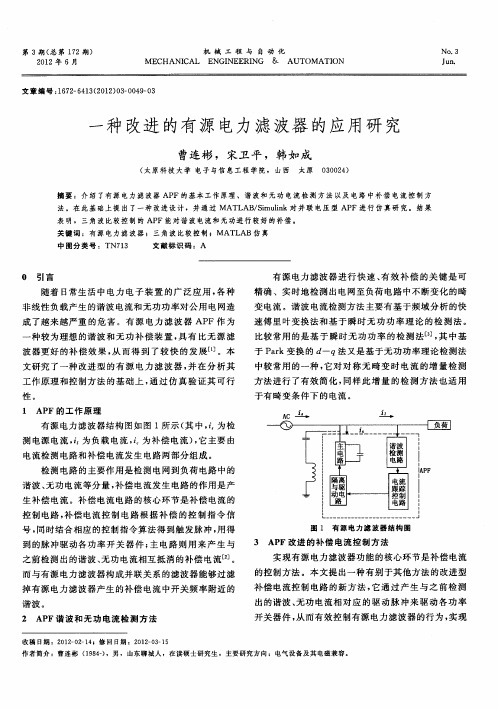
[ ] 陈保 . 联 有 源 电力 滤 波器 实 用 关 键 技 术 研 究 [ . 州 : 4 并 D] 杭
浙 江大 学 ,0 9 2—2 2 0 :93 .
[] 庞浩 , 5 王暂 基 , 建 业 . 联 型 直 流 有 源 电 力 滤 波 器 的控 陈 并
0 1H, . 电容 C一( . ×1 )F。电流 仿 真 波形 如 图 10 0 5 示 。从 仿 真 结果 可 以 看 出 , 角 波 比较 控 制 方 法 所 三 控制 的有源 电力 滤波器能 够实现 较快 的动 态响应 速度
制方 法 , 整个 AP F系统 仿真算 法采用 o e 5 d4 。
・
5 ・ O
机 械 工 程 与 自 动 化
21 0 2年 第 3期
对 谐波 电 流 的有 效 实 时补 偿[ 。 目前 , 常 用 的控 制 4 ] 较
方法有 三 角波 比较控 制 、 环 比较 控制 等 。 滞 三角 波 比较法是 目前应 用 较为广 泛 的一 种线 性 电
波时, 此种 方法 增大 了数字化 控制 器 的难度 。 ]
wa i ltd b ATLAB/ i l k Th e ut h w h tAPF c n r l db ra ge p lec mp rs n meh d c n c mp n ae ssmuae y M S mui . n ers lss o ta o tol ytin l us o aio to a o e s t e
滤 波器 系统对 负载 中的谐 波和无 功 电流进行 了有效 的
( )补偿 前 电流 8
补偿 。随着数字 信号 处理器 技 术 的发展 , D P实 现 用 S 对 AP F的控制 是一 种很 有发展 潜力 的控制 方法 。
有源滤波技术综述
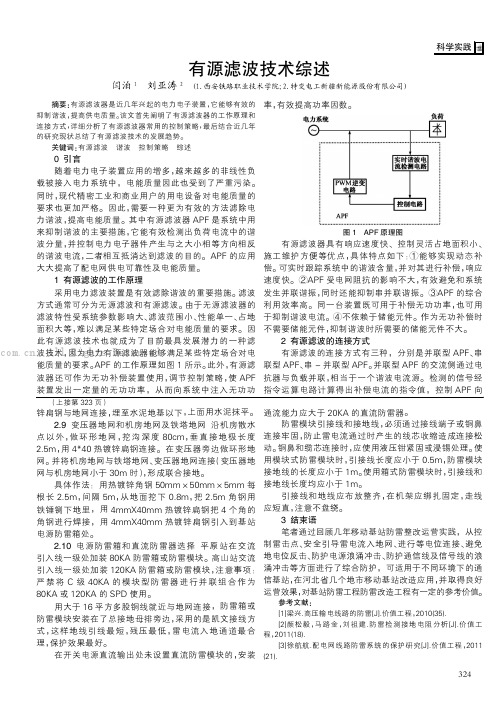
(上接第323页)摘要:有源滤波器是近几年兴起的电力电子装置,它能够有效的抑制谐波,提高供电质量。
该文首先阐明了有源滤波器的工作原理和连接方式,详细分析了有源滤波器常用的控制策略,最后结合近几年的研究现状总结了有源滤波技术的发展趋势。
关键词:有源滤波谐波控制策略综述0引言随着电力电子装置应用的增多,越来越多的非线性负载被接入电力系统中,电能质量因此也受到了严重污染。
同时,现代精密工业和商业用户的用电设备对电能质量的要求也更加严格。
因此,需要一种更为有效的方法滤除电力谐波,提高电能质量。
其中有源滤波器APF 是系统中用来抑制谐波的主要措施,它能有效检测出负荷电流中的谐波分量,并控制电力电子器件产生与之大小相等方向相反的谐波电流,二者相互抵消达到滤波的目的。
APF 的应用大大提高了配电网供电可靠性及电能质量。
1有源滤波的工作原理采用电力滤波装置是有效滤除谐波的重要措施。
滤波方式通常可分为无源滤波和有源滤波。
由于无源滤波器的滤波特性受系统参数影响大、滤波范围小、性能单一、占地面积大等,难以满足某些特定场合对电能质量的要求。
因此有源滤波技术也就成为了目前最具发展潜力的一种滤波技术,因为电力有源滤波器能够满足某些特定场合对电能质量的要求。
APF 的工作原理如图1所示。
此外,有源滤波器还可作为无功补偿装置使用,调节控制策略,使APF 装置发出一定量的无功功率,从而向系统中注入无功功率,有效提高功率因数。
图1APF 原理图有源滤波器具有响应速度快、控制灵活占地面积小、施工维护方便等优点,具体特点如下:①能够实现动态补偿。
可实时跟踪系统中的谐波含量,并对其进行补偿,响应速度快。
②APF 受电网阻抗的影响不大,有效避免和系统发生并联谐振,同时还能抑制串并联谐振。
③APF 的综合利用效率高。
同一台装置既可用于补偿无功功率,也可用于抑制谐波电流。
④不依赖于储能元件。
作为无功补偿时不需要储能元件,抑制谐波时所需要的储能元件不大。
有源电力滤波器英文文献和中文翻译
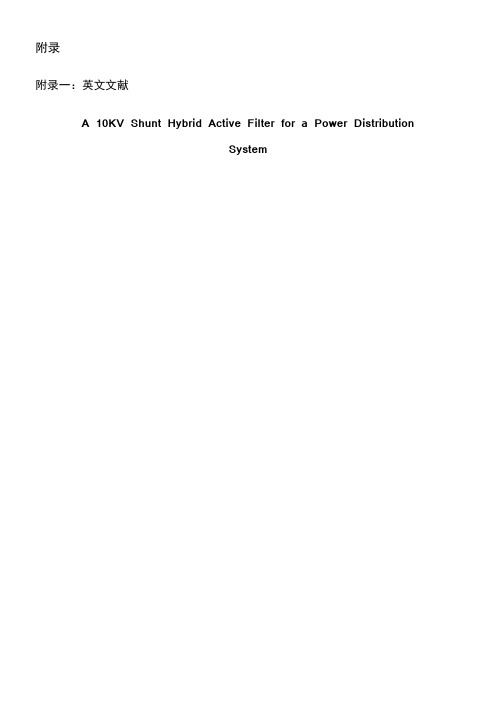
附录附录一:英文文献A 10KV Shunt Hybrid Active Filter for a Power DistributionSystemAbstract—this paper analyzes the compensation performance of a shunt hybrid active power filter. The hybrid active power filter, which combines passive filter and active power filter, has both respective merits, and is an important developing trend of filtering device. The hybrid active power filter can reduce the capacity of active power filter effectively and is more suitable for the engineering application for high voltage nonlinear loads. The compensation performance of hybrid active power filter is analyzed by estimating the effect of different active power filter gain and parameters change. Then, a conclusion has been obtained that the harmonic attenuation rate is insensitive to the variation of passive parameters when the active power filter with an enough feedback gain is combined. Finally, the feasibility and validity of proposed scheme is verified by Simulation using Matlab and a hybrid shunt active power filter prototype.Index Terms:Current harmonics compensation, active power filter, passive filter, generalized integrators.I .INTRODUCTIONIn the development of power electronics brings convenience to energy conversion and utilization and also causes power quality problems. As one of the key technologies in combating power grid pollution and improving the power quality, active power filter (APF) has become a new research emphasis in power electronics technology[1]-[5]. Because of high initial cost, the further application of active power filter is restricted. The HAPF(Hybrid Active Power Filter), combination of APF and passive filter (PF), can reduce the capacity of Affectively and is more suitable for the engineering application of APF for high voltage nonlinear loads.Traditionally, Passive filter has been used to eliminate the harmonic in power system due to his low cost and high efficiency. A passive filter shows the low impedance at tuned frequency to absorb current harmonic and has a good compensation performance. However, passive filter has the disadvantage of depending on the parameters of power system, susceptible to the load and power system resonant and the characteristic change due to aging. In addition, passive filter usually is designed with fixed parameters, which can not be lightly adapted for the variation operation condition.Active power filter has been developed to overcome of disadvantages of passive filter and can provide flexible and reliable compensation, but is not a cost-effective solution duet the high operation cost.Because of the drawbacks of passive filter and active power filter, the research on hybrid active power filter has become more attractive [6]-[9]. Hybrid active power filter composed of passive filter connected in series to an active power filter improves the compensation performance of passive filter remarkably, give more flexibility and reliability to filter device, and redound to the use of active power filter in high-power system avoiding the expensive initial cost.In this paper, the compensation performance of hybrid active power filter in an industrial power distribution system is analyzed by estimating the effect of different active power filter gain and parameters change. Finally, the compensation of hybrid active power filter is verified by simulation and a laboratory prototype. The passive filter of prototype was tuned at the seventh harmonic and the generalized integrators are used to eliminate the 5th, 11th and 13th harmonic current[10].II. PRINCIPLES OF CURRENT HARMONIC COMPENSATION The hybrid active power filter topology is shown in Fig.1, which consists of a three-phase pulse width modulation(PWM) voltage-source inverter (active power filter, APF)and the passive filter connected in series to APF through coupling transformer. Generally, the active power filter acts as a controlled voltage source and force the harmonic current into the hybrid active power filter. The principle of operation of current harmonic is explained by the single-phase equivalent circuit shown in Fig.2 when the feedback control is applied to the active power filter. In the current harmonic compensation strategy, the active power filter is considered as a controlled voltage source VAPF, and ZF is the impedance of passive filter, ILh is the load harmonic current, ZS is the system impedance.In order to eliminate harmonic of the system current, the active power filter is controlled as a current controlled voltage source. The active power filter imposes a voltage signal V APF that forces load harmonic current flow into the passive filter, thus improving its compensation performance in despite of the variation in the tuned frequency of the passive filter. The voltage reference of active power filter is equal toVAPF = K ⋅I sh (1) Where, K is the harmonic compensation gain. Supposing utility voltage is pure sinusoidal, the ration between the utility harmonic current and the load harmonic current is obtained, which can be used to denote the filtering characteristics of hybrid active power filter.Otherwise, K acts as a resistance to damp resonance between ZS and ZF. The larger K is selected, the lower the harmonic contents in the utility current. But thiswill increase the required power rating of the active power filter. In real condition, K is finite. Otherwise, closed loop control system will become unstable.Fig. 1 hybrid active power filter configuration.Fig. 2 Single-phase equivalent circuit of the hybrid active power filter scheme.III. ANALYSIS OF THE HYBRID FILTERPERFORMANCE IN ADISTRIBUTION SYSTEMThis section will show the compensation performance of hybrid active power filter through an example. The power distribution energizes the six medium frequency furnace, each of 300KW rate power. The medium frequency furnaces energized by six pulse uncontrolled rectifiers. The single phase diagram of the power distribution is shown in Fig.3only considering hybrid active power filter and medium frequency furnace.Fig. 3 Single-phase line diagram of the power distribution systemThe system harmonic content and harmonic criterion are shown in Table I and the 5th, 7th and 11th frequency harmonics exceed the criterion. So, the passive filters are tuned at the 5th, 7th and 11th frequency harmonic and the rate of reactive power compensation is 500kVar. The system inductance and the parameters of passive filters are shown in Table II.TABLE IIn this case, the rate of active power filter is 25KVA since it would only compensate current harmonic and the coupling transformers turns ratio is equal to 2.Fig.4 (a) shows the harmonic attenuation rate of passive filter and hybrid active power filter. The hybrid active power filter is characterized by using three single resonant filter tuned at the 5th, 7th and 11th harmonic frequency as shown inFig.3. Therefore, the passive filter presents low impedance at the 5th, 7th and 11th harmonic frequency and their neighborhood. When no active power filter is connected in series with the passive filter, the harmonic amplifying phenomenon appear in the frequency range of 200-240Hz,300-340Hz and 500-640Hz. When the active power filter with a feedback gain of 20 is combined, no harmonic amplifying phenomena occurs. Meanwhile, only adapting the passive filter, the filtering characteristic is unsatisfactory even at the 5th, 7th and 11th harmonic frequency. When the active power filter with a feedback gain of 20 is combined, the harmonic attenuation rate is increased and the filter performance of the hybrid active power filter is satisfactory at the 5th, 7th and 11th harmonic frequency.Fig.4 (b) shows the harmonic content of power system indifferent condition. When no filter is connected in parallel with the utility, the 5th, 7th and 11th harmonic current exceed the criterion seriously. After only adapting the passive filter, the harmonic current of utility is weakened but unsatisfactory adequately. When the active power filter with a feedback gain of 20 is combined, most of 5th, 7th and 11th harmonic current is forced flowing into the hybrid active power filter.Fig.5 shows how the active power filter gain K changes the harmonic attenuation rate of system current. Large value of K improves the hybrid active power filter compensation performance by increase the harmonic impedance of power system.In addition, Fig.5 shows that the low values of passive filter quality factor Q will increases the impedance at the resonant frequency and weaken the compensation performance of hybrid active power filter. The passive filter quality factor Q decides the passive filter bandwidth. Though increasing the value of active power filter gain K can compensate the adverse effect of low value of Q, which would results in the increase of active power filter output voltage required to keep the same compensation performance, thus increasing the active power filter rated power.Fig. 4 Hybrid active power filter frequency response and Harmonic Content.From Fig.5, a conclusion can be received that the quality factor of passive filter and the active power filter gain directly affect the compensation performance of hybrid active power filter when the tuned frequency is fixed. If the quality factor of passive filter is not properly selected, the active power filter gain K must beenincreased to obtain the satisfying compensation performance.Fig. 5 Hybrid active power filter frequency response for different values of passive filter quality factor Q.Fig.6 shows the hybrid active filter frequency response for different values of the system equivalent impedance. Generally, the system equivalent impedance must be lower to the passive filter equivalent impedance at the resonant frequency; otherwise, the passive can not obtain the favorable compensation performance and most load harmonic current will flow to the power system. When no active power filter is connected in series with the passive filter, if utility impedance is lower than the passive filter impedance at the tuned frequency, the harmonic attenuation rate is decreased and the filter performance of passive filter is unsatisfactory, as shown in Fig.6 (a). When the active power filter with an enough feedback gain is combined, the harmonic attenuation rate is insensitive to the variation of utility impedance, as shown in Fig.6 (b).Fig.6 also depicts that the active power filter gain K in bulky utility (small values of Zs) must bigger than that in weak utility (big value of Zs) to obtain the same compensation performance.Fig. 6 Hybrid active power filter frequency response for different values of the system equivalent impedance.The simulation results are shown in Fig.7-10. Fig.7 shows the phase-a load current and it can be seen that the load current is greatly distorted. Fig.8 presents the phase-a supply current when hybrid active power filter is working. Now it can be seen that the hybrid active power filter has improved the quality of supply current markedly and the dominating harmonic current has been eliminated effectively. Fig.9 shows the phase-a hybrid filter current. It consists of 5th, 7thand 11th harmonic current mostly.The dynamic compensation performance is studied by load perturbation response and shown in Fig.10. The change in the source current is observed smooth and steady state is reached within 2 cycles.Fig.7. Simulated current waveforms for hybrid filter compensation. Top: simulate load current; bottom: itsfrequency spectrumFig.8. Simulated current waveforms for hybrid filter compensation. Top: simulate system line current; bottom: itsfrequency spectrum.Fig.9. Simulated current waveforms for hybrid filter compensation. Top: simulate hybrid filter current; bottom: itsfrequency spectrum.Fig.10. Dynamic simulated current waveforms for hybrid filter compensation. Top: simulate system line current;middle: simulate load current; bottom: simulate hybrid filter current.IV. EXPERIMENTAL RESULTSA three-phase hybrid shunt active power filter laboratory prototype using IGBTwas implemented and tested in the compensation of a six-pulse uncontrolled rectifier, as shown in Fig.11. The VSI dc-link voltage is composed of a capacitor bank of 6800μF for a dc-link voltage 450V. The Eupec 1200V/200A IGBT are used and driven by theM57962L gate drivers. The digital control system incorporates a double DSP (TMS320C32 and TMS320F240) and CPLD circuit. The sampling period is 200 μs . Phase detection and control algorithm are completed byTMS320C32, and sampling and SVPWM program are implemented by TMS320F240. The inverter was operated at5-kHz switching frequency and was connected in series to a passive filter directly. The passive filter was tuned at the seventh harmonic (350Hz) and quality factor Q equal to 60.The parameters of the experiment circuit are shown in Table III.Fig.11 PI current controller using generalized integratorsTABLE IIISince such a single seventh harmonic tuned LC filter issued, a no negligible amount of the 5th, 11th and 13thharmonic current still remains in the supply. Thus, the generalized integrators are used to eliminate the 5th, 11th and13th harmonic current.The proposed controller based on generalized integrators in stationary frame is depicted in Fig.12, Where, *VAPF is Violate reference,*is is grid current reference.Fig.12 PI current controller using generalized integratorsWhere, Ki is the integral coefficient. The following discrete formula is use to realize the digital generalized integrators.For reducing the computation time, the generalized integrators are implemented by iterative arithmetic.When generalized integrators are used, the harmonic attenuation rate is shown in Fig.13. Fig.13 illustrates that the5th, 11th, 13th, 17th and 19th harmonic current are eliminated effectively by reason of generalized integrators.In this case, the load current consists of a mass of harmonic current. As shown in Fig.15, when only proportion controller is used, the elimination of harmonics besides tuned frequency is very limited by hybrid active power filter.With hybrid active power filter compensation using PI controller based on generalized integrators, the 5th, 7th, 11th,13th, 17thand 19th harmonics had beeneliminated effectively as shown in Fig.16. When the shunt APF is plunged, the DC linkvoltage can arrive at reference value rapidly, as shown in Fig 7...Fig.14. Experimental load current waveforms. (a) Load current. (b) Load current frequency spectrum. Fig.16. Experimental system current waveforms with hybrid filter compensation. (a) System current. (b) Systemcurrent frequency spectrum.Fig.17. Experimental system current waveforms with hybrid filter compensation.V. CONCLUSIONThe compensation performance of a shunt hybrid active power filter is proposed and analyzed. The hybrid active power filter, which combines passive filter and active power filter, has both respective merits, and is an important developing trend of filtering device. The hybrid active power filter can reduce the capacity of active power filter effectively and is more suitable for the engineering application for high voltage nonlinear loads. The compensation performance of hybrid active power filter is analyzed for different active power filter gain and parameters change. Above all, an conclusion can be obtained that the harmonic attenuation rate is insensitive to the variation of passive parameters when the active power filter with an enough feedback gain is combined. The feasibility and validity of proposed scheme is verified by Simulation using Matlab and a hybrid shunt active power filter prototype.附录二:中文翻译与10kV配电系统并联的混合型有源电力滤波器摘要本文分析了并联混合型有源电力滤波器的补偿性能。
电力有源滤波器综述
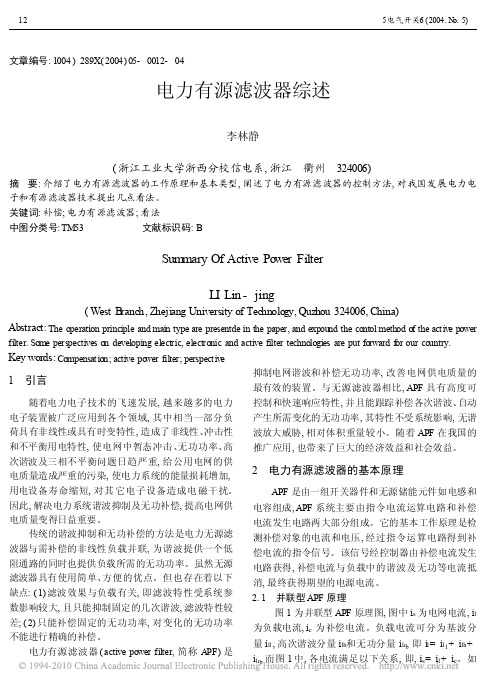
文章编号:1004)289X(2004)05-0012-04电力有源滤波器综述李林静(浙江工业大学浙西分校信电系,浙江衢州324006)摘要:介绍了电力有源滤波器的工作原理和基本类型,阐述了电力有源滤波器的控制方法,对我国发展电力电子和有源滤波器技术提出几点看法。
关键词:补偿;电力有源滤波器;看法中图分类号:TM53文献标识码:BSum mary Of Active Po wer FilterLI Lin-jing(West B ranch,Zhejiang University of Technolo gy,Quzhou324006,China)Abstract:The operation principle and main type are presentde in the paper,and expound the contol method of the active power filter.Some perspectives on developing electric,electronic and active filter technologies are put forward f or our country.Key words:Compensation;active po wer filter;perspective1引言随着电力电子技术的飞速发展,越来越多的电力电子装置被广泛应用到各个领域,其中相当一部分负荷具有非线性或具有时变特性,造成了非线性、冲击性和不平衡用电特性,使电网中暂态冲击、无功功率、高次谐波及三相不平衡问题日趋严重,给公用电网的供电质量造成严重的污染,使电力系统的能量损耗增加,用电设备寿命缩短,对其它电子设备造成电磁干扰。
因此,解决电力系统谐波抑制及无功补偿,提高电网供电质量变得日益重要。
传统的谐波抑制和无功补偿的方法是电力无源滤波器与需补偿的非线性负载并联,为谐波提供一个低阻通路的同时也提供负载所需的无功功率。
有源电力滤波器毕业论文文献综述
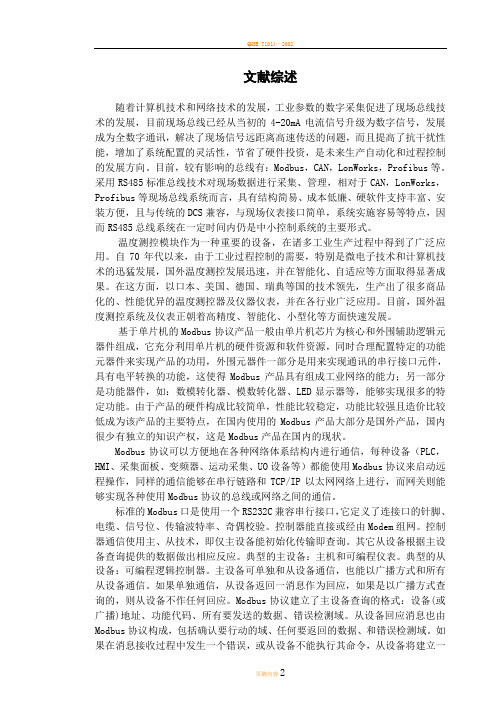
文献综述随着计算机技术和网络技术的发展,工业参数的数字采集促进了现场总线技术的发展,目前现场总线已经从当初的4-20mA电流信号升级为数字信号,发展成为全数字通讯,解决了现场信号远距离高速传送的问题,而且提高了抗干扰性能,增加了系统配置的灵活性,节省了硬件投资,是未来生产自动化和过程控制的发展方向。
目前,较有影响的总线有:Modbus,CAN,LonWorks,Profibus等。
采用RS485标准总线技术对现场数据进行采集、管理,相对于CAN,LonWorks,Profibus等现场总线系统而言,具有结构简易、成本低廉、硬软件支持丰富、安装方便,且与传统的DCS兼容,与现场仪表接口简单,系统实施容易等特点,因而RS485总线系统在一定时间内仍是中小控制系统的主要形式。
温度测控模块作为一种重要的设备,在诸多工业生产过程中得到了广泛应用。
自70年代以来,由于工业过程控制的需要,特别是微电子技术和计算机技术的迅猛发展,国外温度测控发展迅速,并在智能化、自适应等方面取得显著成果。
在这方面,以口本、美国、德国、瑞典等国的技术领先,生产出了很多商品化的、性能优异的温度测控器及仪器仪表,并在各行业广泛应用。
目前,国外温度测控系统及仪表正朝着高精度、智能化、小型化等方面快速发展。
基于单片机的Modbus协议产品一般由单片机芯片为核心和外围辅助逻辑元器件组成,它充分利用单片机的硬件资源和软件资源,同时合理配置特定的功能元器件来实现产品的功用,外围元器件一部分是用来实现通讯的串行接口元件,具有电平转换的功能,这使得Modbus产品具有组成工业网络的能力;另一部分是功能器件,如:数模转化器、模数转化器、LED显示器等,能够实现很多的特定功能。
由于产品的硬件构成比较简单,性能比较稳定,功能比较强且造价比较低成为该产品的主要特点,在国内使用的Modbus产品大部分是国外产品,国内很少有独立的知识产权,这是Modbus产品在国内的现状。
有源电力滤波器综述
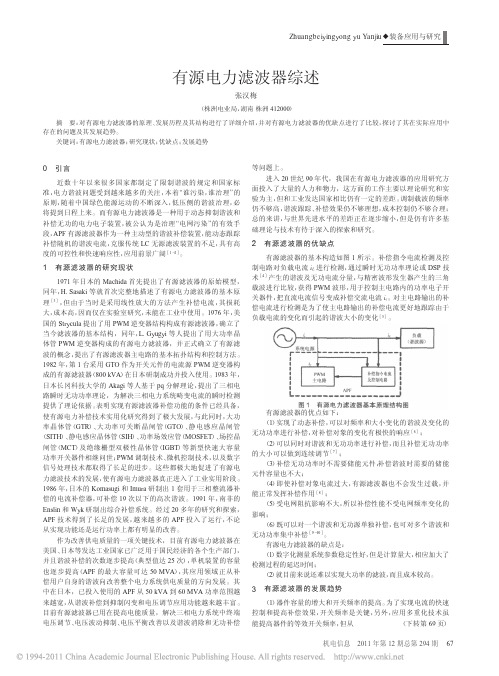
0引言近数十年以来很多国家都制定了限制谐波的规定和国家标准,电力谐波问题受到越来越多的关注,本着“谁污染,谁治理”的原则,随着中国绿色能源运动的不断深入,低压侧的谐波治理,必将提到日程上来。
而有源电力滤波器是一种用于动态抑制谐波和补偿无功的电力电子装置,被公认为是治理“电网污染”的有效手段,APF 有源滤波器作为一种主动型的谐波补偿装置,能动态跟踪补偿随机的谐波电流,克服传统LC 无源滤波装置的不足,具有高度的可控性和快速响应性,应用前景广阔[1-2]。
1有源滤波器的研究现状1971年日本的Machida 首先提出了有源滤波器的原始模型,同年,H.Sasaki 等就首次完整地描述了有源电力滤波器的基本原理[3],但由于当时是采用线性放大的方法产生补偿电流,其损耗大,成本高,因而仅在实验室研究,未能在工业中使用。
1976年,美国的Strycula 提出了用PWM 逆变器结构构成有源滤波器,确立了当今滤波器的基本结构,同年,L.Gyugyi 等人提出了用大功率晶体管PWM 逆变器构成的有源电力滤波器,并正式确立了有源滤波的概念,提出了有源滤波器主电路的基本拓扑结构和控制方法。
1982年,第1台采用GTO 作为开关元件的电流源PWM 逆变器构成的有源滤波器(800kVA)在日本研制成功并投入使用。
1983年,日本长冈科技大学的Akagi 等人基于pq 分解理论,提出了三相电路瞬时无功功率理论,为解决三相电力系统畸变电流的瞬时检测提供了理论依据。
表明实现有源滤波器补偿功能的条件已经具备,使有源电力补偿技术实用化研究得到了极大发展,与此同时,大功率晶体管(GTR)、大功率可关断晶闸管(GTO )、静电感应晶闸管(SITH )、静电感应晶体管(SIH )、功率场效应管(MOSFET )、场控晶闸管(MCT )及绝缘栅型双极性晶体管(IGBT )等新型快速大容量功率开关器件相继问世;PWM 调制技术、微机控制技术,以及数字信号处理技术都取得了长足的进步。
有源电力滤波器的研究综述

想要使项目建设成本控制达到真正的有效控制,就必须严格按照一定的经济责任制要求,贯彻实施责任和权利相匹配的原则类型,只有这样在项目建设过程中完全有效的确定各成本发生中心体系,它们都是有效控制成本的载体。
(四)营房建设项目管理成本控制的方法随着实践和科学研究的不断进行,到现在为止工程建设项目用来成本控制的基本方法和理论依据不断的增加,但是这些方法适合于不同的情况或者说是背景类型,在不同的建设背景下实施不同的控制方法将会产生不同的效果类型。
营房建设项目成本控制的基本方法类型包括以下几种:1.制度控制制度控制是从最基本的施工单位角度对项目成本实施过程中的总体进行宏观有效的控制。
它规定和约定了项目建设成本控制的有效方法和内容,用来解决项目施工建设过程中和成本控制管理中出现的可以有章可循、有例可根的重要问题的解决方法。
2.额度控制为了控制建设项目最终成本的核算结果,建设或者承包单位必须及时获取或者调查完整的市场材料等价格信息资料。
这些最基本的市场资料类型,对比以往历史资料按照一定比例予以控制和计算,由此用于确定建筑安装工程过程中材料基础定额。
3.合同控制为了有效的控制建设过程中的成本,除采取上述的办法用来控制成本外,还经常采取与以上方法相配套的合同控制的办法。
用合同来控制建设成本是指建设企业实施成本建设控制的重要方向之一。
合同管理与其他控制办法的最主要不同之处就在于前面的控制方法大多属于行政控制。
然而项目建设合同控制管理是指建设合作双方在合同自愿协商、自愿负责控制的基础上,产生的按照法律程式和方法具有约束力的有效控制办法。
作者简介:毕胜,1979年生,工作于中国人民解放军65139部队,现在长春工业大学攻读硕士研究生,项目管理专业。
摘要:随着电力电子技术的发展,电力电子装置在电力系统中的应用越来越广泛,应运而生的非线性和冲击性负载产生的谐波及无功电流对公共电网的污染也日渐严重。
在解决谐波问题的众多方法中,有源电力滤波器(APF)是一种相当具有发展前景的谐波抑制装置。
关于有源电力滤波器的综述分析

( Fujian Key Laboratory of New Energy Generation and Power ConversionꎬFuzhou 350116ꎬChina)
与电力系统之间引起并联或串联谐振ꎬ引起谐波放
成污染和公害ꎮ 它不仅会威胁电力系统自身和经济
(2) 谐波使旋转电机、变压器等设备产生额外
设备是非线性的ꎬ谐波污染不可避免ꎬ对电力系统造
大ꎬ严重时可能烧毁电容器以及电抗器ꎮ
的安全稳定运行ꎬ而且会给周围的电力环境带来很
的谐波损耗和压降ꎬ造成电能质量下降ꎬ降低发电和
滤波器( Active Power FilterꎬAPF) 的发展ꎮ APF 作为综合性电能质量调节器ꎬ是一种具备动态谐波抑制和无
功补偿功能的新型电力电子装置ꎬ其性能优劣与所采用的拓扑结构、电流追踪控制方法等密切相关ꎮ 为了推
广在高压大容量下 APF 的控制技术ꎬ拓宽其应用范围ꎬ分类整理了 APF 拓扑结构ꎬ归纳总结了 APF 的电流
类型ꎮ 图 1 为从储能元件、PWM 个数、应用场合电
源相数、接入方式、电压等级五个角度对 APF 拓扑
进行了分类ꎮ
图 2 双重化 APF 拓扑结构
2. 3 根据应用场合电源相数分类
在实际应用 APF 场合中ꎬ根据电源相数的不同
可将拓扑分为单相 APF 和三相 APFꎬ其中分为三相
三线制和三相四线制属于三相 APFꎮ
2. 5 根据电压等级分类
2. 5. 1 低压场合
传统 APF 开关器件少、控制方法简单且易于实
现ꎬ但是受功率器件限制ꎬ输出电流纹波较大ꎬ在中
100 kVA并联型有源电力滤波器的研究
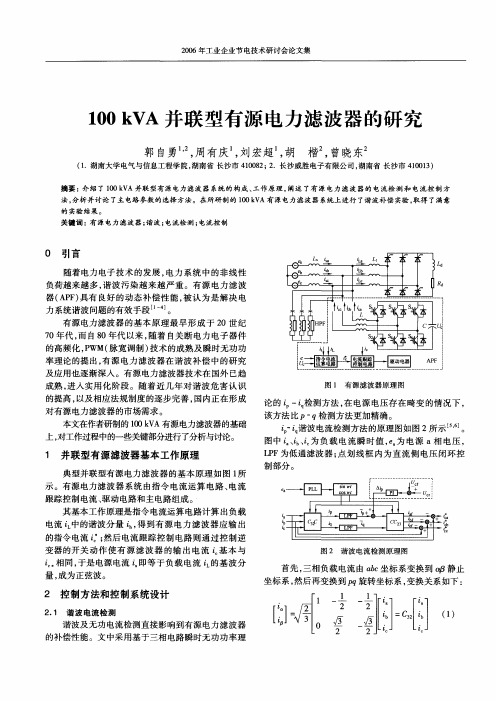
图 1 有源滤波器原理图
论的i i 方法, 源电 存在畸 情况下, 。9 一 检测 在电 压 变的
该方法比P 4 一 检测方法更加精确。
上, 作过 的 对工 程中 一些关键部 进行了 分 分析与 讨论。
;i 波电 检 法的 理图 流 测方 原 如图2 5 0 q 谐 所示[] , 6
图中L b e e J J为负载电流瞬时值, 为电源 a e 。 相电压,
有源电 力滤波器交流侧电 UP 压 A与负荷侧交流电 F 压相同, IF 而 A 的大小和系统的补偿方式有关。当只 P 补偿谐波电流时,P IF A取决于负载电流中谐波的大小; 当补偿谐波和无功电流时,P IF A取决于负载电流中谐波
和无功电流的大小。
开关器件的电流等级应根据有源电力滤波器工作 电流的有效值、 峰值来确定, 通常要留有 1 倍的裕量。
性能。 23 控制系统设计 .
直流侧电容器容量的选择主要是抑制直流电容电 压的过大波动, 在容许的范围内, 电容越大越好, 但是 电容过大会增加装置的成本。 本文所研制的有源电力滤波器系统综合考虑多种
因素 选择直流 压为8 V电 后, 侧电 5 , 容容量加 0 wo 0 0 F 0
上进 于 波 偿 验 ,行 谐 补 实 。
在所研制的 0 V 1 kA并联型有源电力滤波器装置 0
实验系统主电路如图 1 所示, 实验参数: 电源线电 压为30 8 V 系统阻抗忽略不计; , 负荷为三相全控整流
么 么 蕊
图 2 谐波电流检测原理图
首先, 三相负载电流由a 坐标系变换到明 静止 b 。 坐标系, 然后再变换到P 旋转坐标系, 4 变换关系如下:
2 控制方法和控制系统设计
21 谐波电流检测 . 谐波及无功电流检测直接影响到有源电力滤波器 的补偿性能。文中采用基于三相电路瞬时无功功率理
电力有源滤波器特性研究
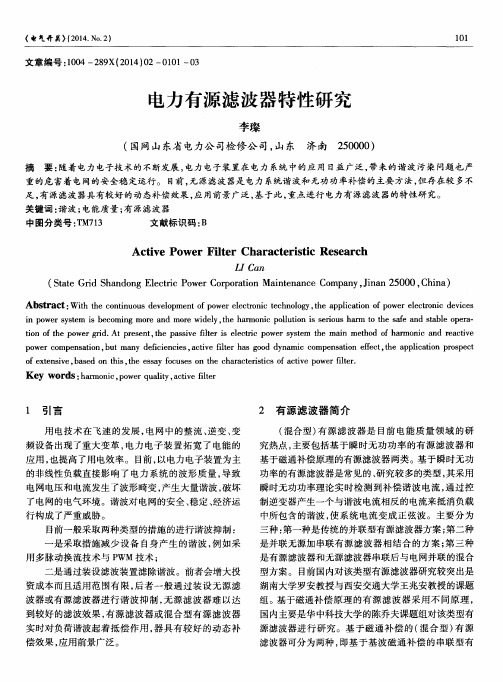
摘 要: 随 着 电力 电子技 术的 不断发 展 , 电力电子 装置在 电 力 系统 中的 应 用 日益 广泛 , 带 来 的谐 波 污 染 问题也 严
重 的危 害 着电 网的安 全稳 定运行 。 目前 , 无 源滤 波器是 电力 系统 谐 波和 无功 功率补 偿 的主要 方 法 , 但存 在较 多不 足, 有 源滤 波器具 有较 好 的动 态补偿 效 果 , 应 用前 景广 泛 , 基 于此 , 重点进行 电力有 源 滤波 器的特 性研 究 。 关键 词 : 谐波; 电能质 量 ; 有 源 滤波 器 中图分类 号 : T M7 1 3 文献 标识 码 : B Ac t i v e Po we r Fi l t e r Ch a r a c t e r i s t i c Re s e a r c h
Ke y wo r ds: h a r mo n i c , p o w e r q u a l i t y, a c t i v e i f l t e r
1 引言
用 电 技术 在 飞 速 的发 展 , 电 网 中的 整 流 、 逆变 、 变
2 有源滤波器简 介
( 混 合型 ) 有 源滤 波 器括 基 于 瞬时 无 功 功 率 的有 源 滤 波 器 和 基 于磁 通补偿 原 理 的有 源 滤波 器两 类 。基 于 瞬 时无 功 功率 的有源 滤波 器是 常见 的 、 研究 较 多 的类 型 , 其采 用 瞬 时无 功功 率理 论实 时 检 测 到 补偿 谐 波 电流 , 通 过 控
论有源电力滤波器
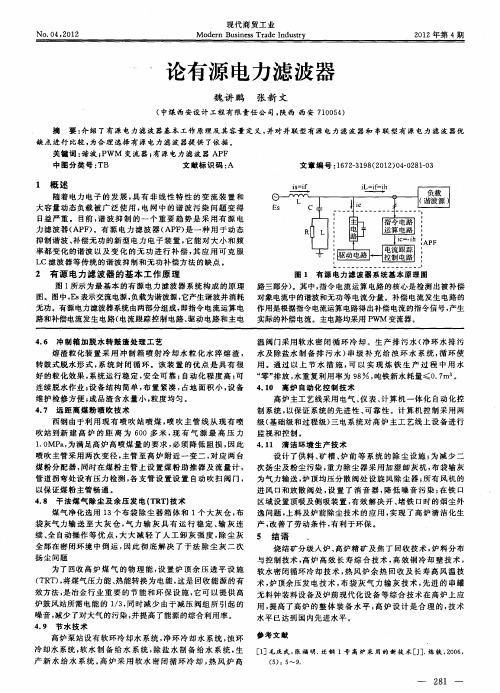
l 概 述
随着 电 力 电 子 的 发 展 , 有 非 线 性 特 性 的 变 流 装 置 和 具 大 容 量 动 态 负 载 被 广 泛 使 用 , 网 中 的 谐 波 污 染 问 题 变 得 电 日益 严 重 。 目前 , 波 抑 制 的 一 个 重 要 趋 势 是 采 用 有 源 电 谐 力 滤 波 器 ( F 。有 源 电 力 滤 波 器 ( P ) 一 种 用 于 动 态 AP ) A F是 抑 制 谐 波 、 偿 无 功 的新 型 电力 电 子 装 置 , 能 对 大 小 和 频 补 它
续 、 自动操 作等 优 点 , 大 减 轻 了人 工 卸灰 强 度 , 尘 灰 5 结 语 全 大 除
缺 点 进 行 比 较 , 合 理 选 择 有 源 电力 滤 波 器 提 供 了依 据 。 为 关 键 词 : 波 ; W M 变流 器 ; 源 电 力 滤 波 器 AP 谐 P 有 F 中图分类号 : TB 文献标识 码 : A
文 章 编 号 :6 23 9 ( 0 2 0 —2 10 1 7 —1 8 2 1 )40 8 —3
煤气净化 选用 1 3个布袋 除 尘器 箱体 和 1个 大灰 仓 , 布 逸 问 题 , 料 及 炉 前 除 尘 技 术 的 应 用 , 现 了 高 炉 清 洁 化 生 上 实 袋灰气 力输 送 至 大 灰 仓 , 力 输灰 具 有 运 行 稳 定 、 灰 连 产 , 善 了劳 动 条 件 , 利 于 环 保 。 气 输 改 有
4 6 冲 制 箱 加 脱 水 转 鼓 渣 处 理 工 艺 .
温 阀 门采用软水 密 闭循 环 冷却 。生 产 排污 水 ( 净环 水排 污 熔渣粒化 装置 采 用 冲 制箱 喷 射冷 却 水粒 化 水 淬 熔渣 , 水 及除盐 水 制备 排 污 水 ) 级 补 充 给 浊环 水 系 统 , 环 使 串 循 转鼓 式脱水 形式 , 系统 封 闭循 环 。该 装 置 的优 点 是具 有 很 用 。通 过 以 上 节 水 措 施 , 以 实 现 炼 铁 生 产 过 程 中 用 水 可 好 的粒化效果 , 系统运行 稳定 , 全可 靠 ; 安 自动化 程度 高 ; 可 “ ” 放 , 重 复 利 用 率 为 9 , 铁 新 水 耗 量 4 o 7 。 零 排 水 8 吨 . m0 连续 脱水作业 ; 设备 结构 简单 , 布置紧 凑 , 占地面 积小 , 备 4 1 高炉 自动 化 控 制 技 术 设 .0 维 护检修方便 ; 品渣含 水量小 , 成 粒度 均匀 。 4 7 远 距 离 煤 粉 喷 吹 技 术 . 高 炉主工艺线采 用 电气 、 仪表 、 计算 机 一体 化 自动化控 制 系统 , 以保证 系统 的先 进性 、 靠 性 。计 算机 控制采 用两 可 西钢 由于利用 现 有 喷吹 站 喷 煤 , 吹 主管 线从 现 有 喷 级 ( 础级和过 程级) 喷 基 三电系 统对 高炉 主工 艺线上 设备 进行
有源电力滤波器的设计
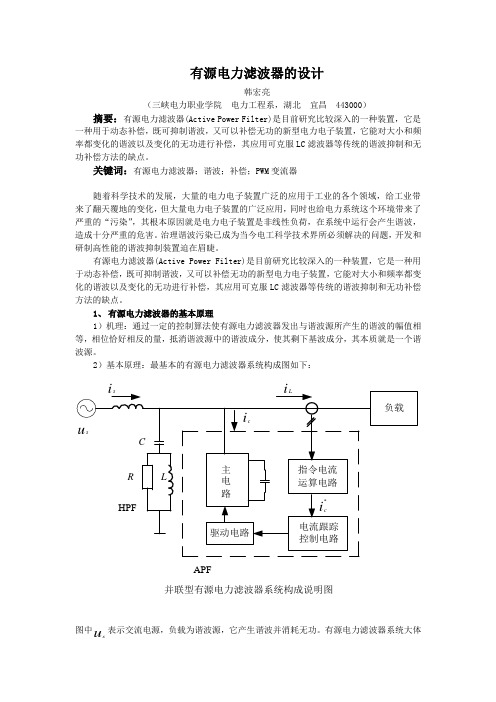
有源电力滤波器的设计韩宏亮(三峡电力职业学院电力工程系,湖北宜昌 443000)摘要:有源电力滤波器(Active Power Filter)是目前研究比较深入的一种装置,它是一种用于动态补偿,既可抑制谐波,又可以补偿无功的新型电力电子装置,它能对大小和频率都变化的谐波以及变化的无功进行补偿,其应用可克服LC滤波器等传统的谐波抑制和无功补偿方法的缺点。
关键词:有源电力滤波器;谐波;补偿;PWM变流器随着科学技术的发展,大量的电力电子装置广泛的应用于工业的各个领域,给工业带来了翻天覆地的变化,但大量电力电子装置的广泛应用,同时也给电力系统这个环境带来了严重的“污染”,其根本原因就是电力电子装置是非线性负荷,在系统中运行会产生谐波,造成十分严重的危害。
治理谐波污染已成为当今电工科学技术界所必须解决的问题,开发和研制高性能的谐波抑制装置迫在眉睫。
有源电力滤波器(Active Power Filter)是目前研究比较深入的一种装置,它是一种用于动态补偿,既可抑制谐波,又可以补偿无功的新型电力电子装置,它能对大小和频率都变化的谐波以及变化的无功进行补偿,其应用可克服LC滤波器等传统的谐波抑制和无功补偿方法的缺点。
1、有源电力滤波器的基本原理1)机理:通过一定的控制算法使有源电力滤波器发出与谐波源所产生的谐波的幅值相等,相位恰好相反的量,抵消谐波源中的谐波成分,使其剩下基波成分,其本质就是一个谐波源。
2)基本原理:最基本的有源电力滤波器系统构成图如下:APF并联型有源电力滤波器系统构成说明图u表示交流电源,负载为谐波源,它产生谐波并消耗无功。
有源电力滤波器系统大体图中s上由两大部分组成,即指令电流运算电路和补偿电流发生电路。
其中指令运算电路的核心部分就是谐波和无功电流检测电路,其主要作用就是检测出需要补偿对象电流中的谐波和无功等电流分量;补偿电流发生电路由电流跟踪控制电路、驱动电路和主电路三部分组成。
其作用是根据指令电流运算电路得出的补偿电流的指令信号,产生实际的补偿电流,主电路多为桥式PWM变流器。
有源电力滤波器的研究
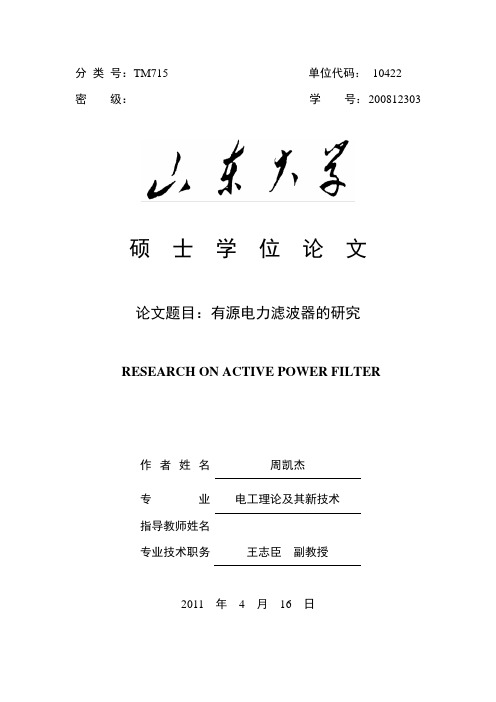
分类号:TM715 单位代码:10422密级:学号:200812303硕士学位论文论文题目:有源电力滤波器的研究RESEARCH ON ACTIVE POWER FILTER作者姓名周凯杰专业电工理论及其新技术指导教师姓名专业技术职务王志臣副教授2011 年 4 月16 日原创性声明本人郑重声明:所呈交的学位论文,是本人在导师的指导下,独立进行研究所取得的成果。
除文中已经注明引用的内容外,本论文不包含任何其他个人或集体已经发表或撰写过的科研成果。
对本文的研究做出重要贡献的个人和集体,均已在文中以明确方式标明。
本声明的法律责任由本人承担。
论文作者签名:日期:关于学位论文使用授权的声明本人完全了解山东大学有关保留、使用学位论文的规定,同意学校保留或向国家有关部门或机构送交论文的复印件和电子版,允许论文被查阅和借阅;本人授权山东大学可以将本学位论文的全部或部分内容编入有关数据库进行检索,可以采用影印、缩印或其他复制手段保存论文和汇编本学位论文。
(保密论文在解密后应遵守此规定)论文作者签名:______ 导师签名:___________日期:________目录摘要 (I)ABSTRACT ................................................................................................................. I II 第一章绪论 (1)1.1谐波的产生及其危害 (1)1.1.1 谐波的产生 (1)1.1.2 谐波的危害 (2)1.2谐波的抑制技术 (3)1.3有源电力滤波器的研究现状和发展 (4)1.3.1 有源电力滤波器的发展历史 (4)1.3.2 有源滤波器的发展前景 (6)1.4谐波电流检测现状 (7)1.5本课题的研究内容 (9)第二章有源电力滤波器的工作原理和基本结构 (10)2.1有源电力滤波器的工作原理 (10)2.2有源电力滤波器的系统结构 (11)2.2.1 并联型有源滤波器 (12)2.2.2 串联型有源电力滤波器 (13)2.2.3 串-并联型有源电力滤波器 (14)2.3有源电力滤波器主电路形式 (14)2.4并联型有源电力滤波器补偿特性分析 (15)第三章基于瞬时无功的谐波检测算法的研究 (19)3.1瞬时无功功率理论 (19)3.2基于瞬时无功传统的谐波电流检测方法 (22)13.2.1 p q-检测法 (22)3.2.2i i-检测法 (23)p q3.2.3 两种检测算法的比较和缺陷 (24)3.2.4 应用于三相四线制系统的p qi i-法 (25)-法、p q3.3基于0--坐标变换的任意次谐波检测算法 (26)d q3.3.1 特定次谐波电流正序分量的检测 (27)3.3.2 特定次谐波电流负序分量的检测 (28)3.3.3 特定次谐波电流零序分量的检测 (28)3.3.4 特定次谐波电流的检测 (29)3.4数字低通滤波器(LPF) (29)3.5 谐波检测算法的仿真研究 (30)3.5.1 MATLAB/SIMULINK简介 (30)3.5.2 仿真模型设计 (31)3.6本章小结 (38)第四章有源电力滤波器控制策略研究 (40)4.1 电流跟踪控制策略 (40)4.1.1 几种电流跟踪策略的研究 (40)4.1.2 瞬时值比较方式的MATLAB实现 (42)4.2直流侧电压稳定性控制 (43)4.2.1 直流侧电压波动的原因 (43)4.2.2 直流侧电压控制策略 (43)4.2.3 模糊PI控制的实现 (44)4.3 本章小结 (46)第五章并联型有源电力滤波器仿真研究 (48)5.1 并联型有源电力滤波器主要参数设计 (48)25.1.1 电压型PWM逆变器的数学模型的建立 (48)5.1.2 主电路直流侧电容的选取 (50)5.1.3 交流侧电感的选取 (51)5.1.4 串联电抗器的选取 (52)5.2并联型有源电力滤波器基于MATLAB仿真 (53)5.2.1 仿真模型的参数选定 (53)5.2.2 仿真结果分析 (53)第六章总结与展望 (56)参考文献 (58)致谢 (62)攻读硕士期间发表的论文及参与的项目 (62)34摘要近年来由于电力电子等非线性设备的大规模使用,在电网中产生了大量的谐波,致使电网污染日益严重,并对人们的日常生产和生活造成了极大的危害,因此采取必要的措施来抑制谐波、提高电能质量已刻不容缓。
滤波器相关的参考文献
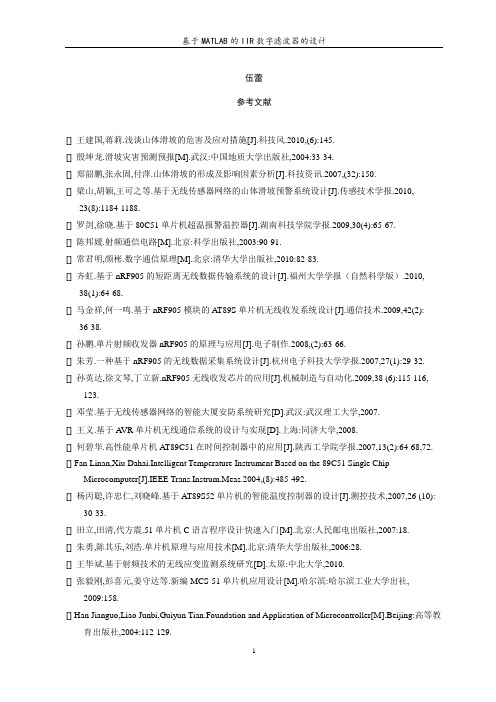
伍蕾参考文献[] 王建国,蒋莉.浅谈山体滑坡的危害及应对措施[J].科技风.2010,(6):145.[] 殷坤龙.滑坡灾害预测预报[M].武汉:中国地质大学出版社,2004:33-34.[] 郑韶鹏,张永固,付萍.山体滑坡的形成及影响因素分析[J].科技资讯.2007,(32):150.[] 梁山,胡颖,王可之等.基于无线传感器网络的山体滑坡预警系统设计[J].传感技术学报.2010, 23(8):1184-1188.[] 罗剑,徐晓.基于80C51单片机超温报警温控器[J].湖南科技学院学报.2009,30(4):65-67.[] 陈邦媛.射频通信电路[M].北京:科学出版社,2003:90-91.[] 常君明,颜彬.数字通信原理[M].北京:清华大学出版社,2010:82-83.[] 齐虹.基于nRF905的短距离无线数据传输系统的设计[J].福州大学学报(自然科学版).2010, 38(1):64-68.[] 马金祥,何一鸣.基于nRF905模块的A T89S单片机无线收发系统设计[J].通信技术.2009,42(2): 36-38.[] 孙鹏.单片射频收发器nRF905的原理与应用[J].电子制作.2008,(2):63-66.[] 朱芳.一种基于nRF905的无线数据采集系统设计[J].杭州电子科技大学学报.2007,27(1):29-32. [] 孙英达,徐文琴,丁立新.nRF905无线收发芯片的应用[J].机械制造与自动化.2009,38 (6):115-116, 123.[] 邓莹.基于无线传感器网络的智能大厦安防系统研究[D].武汉:武汉理工大学,2007.[] 王义.基于A VR单片机无线通信系统的设计与实现[D].上海:同济大学,2008.[] 何碧华.高性能单片机A T89C51在时间控制器中的应用[J].陕西工学院学报.2007,13(2):64-68,72. [] Fan Linan,Xiu Dahai.Intelligent Temperature Instrument Based on the 89C51 Single Chip Microcomputer[J].IEEE Trans.Instrum.Meas.2004,(8):485-492.[] 杨丙聪,许忠仁,刘晓峰.基于AT89S52单片机的智能温度控制器的设计[J].测控技术,2007,26 (10): 30-33.[] 田立,田清,代方震.51单片机C语言程序设计快速入门[M].北京:人民邮电出版社,2007:18.[] 朱勇,陈其乐,刘浩.单片机原理与应用技术[M].北京:清华大学出版社,2006:28.[] 王华斌.基于射频技术的无线应变监测系统研究[D].太原:中北大学,2010.[] 张毅刚,彭喜元,姜守达等.新编MCS-51单片机应用设计[M].哈尔滨:哈尔滨工业大学出社, 2009:158.[] Han Jianguo,Liao Junbi,Guiyun Tian.Foundation and Application of Microcontroller[M].Beijing:高等教育出版社,2004:112-129.[] 隋冶.基于AT89C51系列单片机的倒计时器制作研究[J].鸡西大学学报,2011,11(3):66-68. [] 林伸茂,管继斌,雁钧.8051单片机彻底研究基础篇[M].北京:人民邮电出版社,2004:96. [] 赵文博,刘文涛.单片机语言C51程序设计[M].北京:人民邮电出版社,2005:1.张少辉参考文献[] 杨爱琴,黄联芬等.滤波器的发展与展望[J].电子科技.1995,(2):7-11.[] CHI-TSONG C. Digital Signal Processing-Spectral Computation and Filter Design[M].London Oxford University Press,2002:198-205.[] 蒋明.数字滤波器的设计与算法实现[J].微电子学与计算机.2000,2(1):16-19.[] 彭红平,杨福宝.基于MA TLAB的FIR数字滤波器的设计[J].武汉理工大学学报.2005,10(5):275- 278.[] 程佩青.数字信号处理教程[M].北京:清华大学出版社,2007:222-223.[] 倪养华,王董玮著.数字信号处理:原理与实现[M].上海:上海交通大学出版社,1999.12:157-158[] 飞思科技产品研发中心.辅助信号处理技术与应用[M].北京:电子工业出版社,2005:281-282. [] Emmanuel.C.Ifeachor. Digital Signal Processing-A practical Approach[M].北京:电子工业出版社, 2004:122-125.[] 张洪涛,万红,杨述斌.数字信号处理[M].武汉:华中科技大学出版社,2006.10:163.[] 周辉,董正宏.数字信号处理基础及MATLAB实现[M].北京:北京希望电子出版社,2002:230- 237.[](美)安东尼奥著,程湘君等译.数字滤波器分析与设计[M].西安:陕西科学技术出版社,1984:89- 102.[] 刘益成,孙祥娥著.数字信号处理[M].北京:电子工业出版社,2004.3:198-203.[] 陈怀琛著.数字信号处理教程:MA TLAB释义与实现[M].北京:电子工业出版社,2004:209-220.[] 俞卞章著.数字信号处理[M].西安:西北工业大学出版社,2002:135-140.[](美)普罗奇斯著,张晓林译.数字信号处理[M].北京:电子工业出版社,2004:507-510.[] 樊昌信,曹丽娜著.通信原理[M].北京:国防工业出版社,2007:56-61.[] 刘明,徐洪波,宁国勤.数字信号处理:原理与算法实现[M].北京:清华大学出版社,2006:197-205.[] 史密斯著,张瑞峰等译.数字信号处理[M].北京:人民邮电出版社,2010:218-222.[] 石云霞,张志伟,范秋华.MATLAB在滤波器设计中的应用[J].青岛建筑工程学院学报.2004,25(2):93.[] 维纳.K.恩格尔,约翰.G.普罗克思.数字信号处理:从原理到应用[M].西安:西安交通大学出版社,2002.6:250-264.[] Sanjit K.Mitra.Digital Signal Processing:A Computer-Based Approach[M].北京:清华大学出版社,2001.8:190-195.李菲参考文献[1] 胡广书.数字信号处理、理论、算法与实现[M].北京:清华大学出版社,1997:23-27.[2] 楼顺天,李博菡.基于MA TL AB 的系统分析与设计-信号处理[M].西安:西安电子科技大学出版社,1998:48-55 .[3] L N De Castro , F J V on Zuben. An Evolutionary Immune Network forDataClustering[C].Proceedingof the IEEE SBRN ,2000:84- 89.[4] 程佩青.数字信号处理教程[M] . 北京:清华大学出版社,2001:224-230.[5] 丁玉美,高西全.数字信号处理2版[M] .西安:西安电子科技大学出版社, 2001:73-85.[6] 罗军益,李磊民,陈泉根. IIR 滤波器的设计研究[J].微计算机信息, 2 0 0 7:44-52 .[7] Powell and Chau: "A Technique for realizing linear phase IIR filter" in IEEE Transactions on SignalProcessing[J].VOL.39, No.11, NOVEMBER 1991, 2425- 2435.[8] Fejzo Z., H.Lev- ari.Aadaptive Laguerre - lattice filters [J].IEEE Trans. Signal Processing,1997,45:3006- 3016.[9] 方小明,姚善化. 基于MATLAB 辅助设计IIR滤波器的方法研究[J] . 仪表技术, 2008:321-330.[10] 倪养华. 数字信号处理与实现[M] .上海:上海交通大学出版社,1998:23-41.[11] 胡广书. 数字信号处理:理论、算法与实现[M] .北京:清华大学出版社,1997.144-147.[12] 邓华,张振中,张海洋. MA TLAB通信仿真与应用实例详解[M] .北京:人民邮电出版社,2003:171-175.[13] 王钦笙.数字通信[M].北京:人民邮电出版社.1993:212-220[14] 王世一.数字信号处理[M] .北京:北京理工大学出版社,2003,2,重版[15] 楼顺天、李博菡. 基于MA TLAB的系统分析与设计-信号处理[M] .西安:西安电子科技大学出版社,1998:155.[16] 施阳. MA TLAB语言工具箱[M].西安:西北工业大学出版社,1999:163-165.[17] 王沫然. Simulink建模及动态仿真[M].北京:电子工业出版社,2002:311-320.[18] 张志涌.精通MATLAB5.3版[M].北京:北京航空航天大学出版社,2000:274-277.[19] 薛定宇.基于MA TLAB/Simulink的系统仿真技术与应用[M].北京:清华大学出版社,2002:251-253.[20] 王华奎,张立毅.数字信号处理及应用[M] .北京:高等教育出版社,2004:166.康鑫参考文献[1] 屠德纪.自动气象站组网与GPS无线通信[J].气象水文海洋仪器.2006,9(3):31-34.[2] 李黄.自动气象站实用手册[M].北京:气象出版社,2007:16-35.[3] 全国大学生电子设计竞赛获奖作品汇编[M].北京:北京理工大学出版社,2004:24-26.[4] 李勇,艾竹君,刘巧云.一种新型温湿度测量系统的设计[J].低温与超导.2007,35(5):451-452.[5] 伍萍辉,廖智,赵葵银.传感器世界[J].应用学报.2001,2(V018):29-32.[6] 李忠海.1KW调频发射机固态改造[J]. 广播与电视技术.2005,32(04):79-92.[7] 要忠.调频发射机自动监控报警器原理分析[J]. 声屏世界.2005,12(03):41-74.[8] 代芬,漆海,霞俞龙.几种常用逻辑电平电路的特点及应用[J].电子设计应用.2005,5(6):77-79.[9] 顾晓春,徐进. 低泄露限幅器的研究[J].半导体情报.2000,4(03):32-56.[10] Caverly R H, Quinn M J. Time domain modeling of PIN control and limiter diodes [J].IEEE MTT-SDigest.1999, 34(23):719-722.[11] 浦志卫.音频功率集成电路及功率器件研究[D].浙江:浙江大学出版社,2006.[12] 陈钰.一种采用交错耦合VCO和高速前置分频器的频率合成器[J].微电子学.2001,3(8):22-47.[13] Wang guang jun.DS18B20:1-Wire Digital Thermometer [J].DALLAS.1999, 5(8):4-7.[14] 宋家友.集成电子线路设计手册[M].福建:福建科学技术出版社,2002:112-134.[15] 高鹏,安涛,寇怀成Protel99 入门与提高[M].北京:人民邮电出版社,2000:8-203.[16] 张友汉.电子线路设计与应用[M].福建:福建科学技术出版社,2001:44-54.[17] 何强,王丹.基于MC145152-2芯片的频率合成器的设计[J].电子工程师.2003,4(31):33-42.[18] 张毅刚.MCS-51单片机原理及应用(第三版)[M].哈尔滨:哈尔滨工业大学出版社,2004:378-390.[19] 郑义,陈俊.用AT89C52和TLC1543实现数据采集系统[J].电子世界.2004,15(2):24-25.[20] Pan Dawei, Wang Pu.12864LCD waveform display system based on research[J].Instrumentation..2008, 3(22):107-141.[21] 景巧健,尹清华.MG-12864液晶显示器在智能仪表中的应用[J].化工自动化及仪表.2003,30(6):62-64.[22] Yu Dan, Chen Guangdong. Universal character LCD display and computer interface design [J]. Transport.2004, 6(12):62-79.胡玉婷参考文献[1] 张亚涛,赵红武,红波.电力自动气象站集成网络系统设计与实现[J].机械机电.2008,36(27):79-82.[2] 高太长,刘西川,刘磊.自动气象站及气象传感器发展状况和前景分析[C].第三届全国虚拟仪器大会论文集. 南京:解放军理工大学出版社,2008:128-129.[3] 伍萍辉,廖智,赵葵银.传感器世界[J].应用学报.2001,25(04):29-32..[4] 夏伟.关于远程测温系统的研究[J].石家庄经济学院信息工程.2006,43(12):34-38.[5] 黄海云,刘华珠,孙玲玲.低功耗CMOS限幅器放大器设计[J].电路与系统学报.2007,12(05):7-9.[6] 赵静.晶体三极管管脚判别[J].电子制作.1998,12(01):9-12.[7] 陈珍,张悲鸿.集成锁相环“CD4046”的研究与开发[J].兰州铁道学院学报.1993,34(23):24-26.[8] Lei Shaogang. CD4046 PLL-based composition and application of [D]. Xi'an:College of AviationTechnology, 2006.[9] 刘杰.移频轨道电路参数测试及信号处理技术的研究[D]. 哈尔滨:哈尔滨理工大学,2003.[10] 金凤莲,李福军.应用PSPICE程序辅助分析鉴频放大器[J].电子与自动化.1995,23(07):42-45.[11] 田玲,黎飞.电子电路与综合实验课程建设研究与实验[J].电气电子教学学报.2006,22(05):19-23.[12] ZHANG You-de.single-chip microprocessor theory.application and test[M].shanghai:FudanUniversity Press,2003:34-54.[13] 张斌,吴从兵,周自泉.基于AT89C52下智能化电镀设备控制系统设计[J].电子技术.2008,35(11):24-36.[14] 李素环,叶斌.应用单片机实现现场非接触温度测量控制技术[J].电子世界.2002,33(06):29-34.[15] Pan Dawei, Wang Pu. 12864LCD waveform display system based on research[J].Instrumentation.2008,10(06): 107-141.[16] 赵娟,高正明,李艳丽.点阵式汉子电子显示屏的设计制作[J].第二炮兵工程学院.2002,22(11):22-35.[17] 杨海涛,于久思,祖士珍.内置SED1520控制驱动器的图形液晶显示模块MGLS-12032A在智能测试仪中的应用[J].国外电子元器件.2006,11(09):11-33.[18] 徐云强,刘蓉.液晶控制器SED1520与单片机mPSD3334D的接口及显示设计[J].电子设计应用.2007,23(06):33-47.[19] 陈光达,何莘.MGLS-12032A/B液晶显示模块及与单片机的软硬件接口[J].电子科技.1999,19(12):9-10.[20] 陈力平.SED1520控制器在环境监测系统中的应用[J].微计算机信息.2006,34(21):24-37.[21] 精电蓬远.内置SED1520控制器图形液晶显示模块使用手册(第二版)[M].北京:北京精电蓬远显示技术有限公司,2003:12-34.[22] 李红萍,贾秀明.基于单片机的电子显示屏控制系统的设计[J].兰州实华职业技术学院.2006,22(07):11-19.[23] 王幸之.AT89系列单片机原理与应用[M].北京:北京航空航天大学出版社,2004:33-35.[24] 张毅刚.MCS-51单片机原理及应用(第三版) [M].哈尔滨:哈尔滨工业大学出版社,2004: 78-90.刘强参考文献[1] 范维澄,王清安等.火灾学简明教程[M].合肥:中国科学技术大学出版社,1995:10-22.[2] 花铁森,吴启鹏.新世纪消防科学技术展望[J].中国消防大全.2000,8(15):4-5.[3] Stephenson,M.D.Automatic Fire Detection Systems.Wiring Installations and Supplies[M].californiausa:electronic trend publications.1985,156(7):239-243.[4] 李宏文,张向阳.建筑物火灾监控系统的智能化发展[J].工程设计CAD与智能建筑,2002,(2):21-25.[5] 宋中才.智能建筑中火灾自动报警系统的设计[J].重庆邮电学院学报,2003,(9);96-98.[6] BukowskiR.W.,BudnickE.K.,SehemelC.F. Estimates of the Operational Reliability of Fire ProtedionSystems[J].Fire Protection Engineering,2002,6(5):134-150.[7] 李力.中国火灾探测技术的现状及发展趋势[J].火灾科学.2001, 10(2): 116-119.[8] 晓京.火灾探测报警技术的发展趋势[J].安徽消防.2003,2(3):127-153.[9] Texas Instruments company,High speed CMOS PLL CD4046A product datasheet,2003.[10] 陈邦媛.射频通信电路[M].北京:科学出版社,2004: 373-376.[11] 阳昌汉.高频电子线路[M].哈尔滨:哈尔滨工程大学出版社,2000:74-91.[12] 王幸之.单片机应用系统抗干扰技术[M].北京:北京航空航天大学出版社,1999:50.[13] 李明.NTC热敏电阻用于可燃性气体监测的研究[J].热敏电阻技术.2000,15(2):30-60.[14] 顾文照,顾月清等.催化燃烧式可燃气体微机化监测技术研究传感技术[M].辽宁:辽宁大学出版社,1999:63-68.[15] 张达明.单片机微机控制及应用技术[M].北京:机械工业出版社,2006:384-386.[16] 纪达.单片机应用系统开发实例导航[M].北京:人民邮电出版社,1996:125-131.[17] 刘建周,范健,王小刚.催化燃烧反应与甲烷传感器稳定性的研究[J].煤矿安全.2002,15(6):10-30.[18] 王宜怀.12位A/D转换器TLC2543与51系列单片机接口技术[J].苏州丝绸工学院学报,1999,(05)23-47.[19] 李宏,张家田等.液晶显示器件应用技术[M].北京:机械工业出版社,2005:37-76.[20] 北京青云创新公司.图形点阵模块LCM240128ZK使用说明书,2004:6-34.[21] 石成英,李进军,刘志强.图形点阵液晶显示模块与单片机接口技术[J].国外电子测量技术.2004(4):50-53.[22]Graeb DA. Computed tomographic diagnosis of intraventricular hemorrhage[J].Etiology andPrognosis,Radiology.2002,143(1):130-145.韩冰参考文献[1] 花铁森.消防报警产品和系统的技术现状与市场[J].安防科技.2003,67(6):4-12.[2] Stephenson. Automatic fire detection systems [J].Wirin Installations and Supplies.1985,31(3): 239-243.[3] 李宏文,张向阳.建筑物火灾监控系统的智能化发展[J].工程设计CAD与智能建筑.2002,(2): 21-25.[4] 宋中才.智能建筑中火灾自动报警系统的设计[J].重庆邮电学院学报(自然科学版).2003,(9): 96-98.[5] Holt,Mike. Fire alarm signaling systems [J].Electrical Construction and Maintenance.2003,102(8):40,42-43.[6] [美]理查德·S·休斯顿.对数视频放大器[D].北京:国防工业出版社,1978.[7] 孔有林.集成运算放大器及其应用[M].北京:人民邮电出版社,1988:20-27.[8] 唐文彦.传感器(第4版)[D].北京:机械工业出版社,2007.[9] 刘迎春,叶祥斌.传感器原理设计与应用[M].长沙:国防科技大学出版社,2004:102-115.[10] 杨帮文.最新传感器实用手册[M].北京:人民邮电出版社,2004:50-80.[11] 刘灿军.实用传感器[M].北京:国防工业出版社,2004:16-28.[12] Y Chen. Dynamic power manage ment based on Wavelet Neural Network in Wireles Sensor Networks[J].IEEE Computer Society.2007,33(7):431-436.[13] 陈莉,陶正苏.环境监测无线传感器网络节点的设计[J].仪表技术与传感器.2008,86(10):7-8.[14] 刘士兴,张永明等.一种无线传感器网络火灾监测系统的设计与实现[J].传感器与微系统.2008,(10):101-104.[15] 张大踪,杨涛,魏东梅.一种低功耗无线传感器网络点的设计[J].仪表技术与传感器.2006,46(10):54-57.[16] P Turk. Embebbed modem data book [J].TDK semiconducting corp.1997,34(2):51-76.[17] 杨振江,蔡德芳.新型集成电路使用指南与典型应用[M].西安:西安电子科技大学出版社,1998:32-37.[18] 万心平,张厥胜.集成所相环路-原理,特性,应用[M].北京:人民邮电出版社,1990:45-49.[19] 童诗白,华成英.模拟电子技术基础[M].北京:高等教育出版社,2004:67-74.[20] 胡宴如.高频电子线路[M].北京:高等教育出版社,2002:34-43.[21] M Kass. Iris identification of acquisition system research [J].Computer security.2007,3(2):449-456.[22] 博战捷,刘淑琴,刘美玲.过调幅AM信号的参数测量与计算[J].电声技术.2007,31(3):34-36.参考文献[1] 徐广文,谢兆鸿等.粮仓温度检测无线传输系统的研究[J].粮食储藏.2005,(34):49-51.[2] 马寿安.中央储备粮代储监管工作的经验总结与问题分析[J].粮油仓储科技通讯.2005,(3):2-4.[3] 王博,李迅,马宏绪等.基于nRF2401的无线数据传输系统[J].电子工程师.2004,30(8):17.[4] Qingshan Shan,Brown D,Ying Liu.Wireless temperature sensor network for refrigeratedvehicles[J].Industrial Electronics,IEEE.2005,(3):1209-1214.[5] 吴栋苗.无线射频数据采集系统及其应用[J].煤炭技术.2005,(24):07-23.[6] 张彦兵,刘永前,李义强.1-Wire总线驱动电路设计[J].传感技术学报.2006,19(4):1020.[7] Dallas Semiconductor Corporation.DSl8B20 Programmable Resolution 1-wire Digital Thermometer[P].Product Datasheet.2002.[8] Nordic.SEMICONDUCTOR Single chip 2.4GHz Transceiver[P].Product Specification,Datasheetorder code:070604-nRF2401,2004.[9] 刘雨刚,洪炳林,郝文慧.基于DSl8B20的高精度矿用温度传感器设计[J].国外电子元器件.2006,(12):35.[10] 丁晓进,史小军,朱为.基于DSl8B20的多点温度检测[J].电子工程师.2006,32(7):12.[11] 雷振亚.射频/微波电路导论[M].西安:西安电子科技大学出版社,2005:13-49.[12] 陈锋,余强.基于nRF24L01的无线温度监测系统[J].工业控制计算机,2010,(12):24-26.[13] 田爽,闫晨光.粮仓无线温度测控及报警系统[J].微计算机信息,2010,(17):15-17.[14] 李荣正,刘启中,陈学军编著.PIC单片机原理及应用[M].北京:北京航空航天大学出版社,2005:57-98.[15] 张毅刚,彭喜元,姜守达,乔立岩编著.新编MCS-51单片机应用设计(第二版)[M].哈尔滨:哈尔滨工业大学出版社,2006:103-146.[16] 曾鹏,于海斌等.现场级无线通信协议研究[J].信息与控制,2002,3l(5):396-400.[17] 沈红卫.单片机应用系统设计实例与分析[M].北京:北京航空航天大学出版社,2003:253-264.[18] 谭浩强著.C程序设计(第三版)[M].北京:清华大学出版社,2005:270-321.[19] 张军,吴建锋.基于无线传感器网络的温湿度检测系统[J].杭州电子科技大学学报,2010,(6):26-28.[20] 谭辉.nRF无线SOC单片机原理与高级应用[M].北京:北京航空航天大学出版社,2009:75-82.[21] 范博.射频电路原理与实用电路设计[M].北京:机械工业出版社,2006:45-63.[] Nicholson S E.A pollution model for street-level air.Atmospheric Environment[J].1975,9:19-31.[] Forman R T T,Alexander L E.Roads and their major ecological effects[J].Annual Review of Ecology and Systematic.1998,(29):207-231.[] 程子峰,徐富春.环境数据统计分析基础[M].北京:化学工业出版社,2006:100-103.[] 杨雷,郑国恒,潘跃年,裴红星.基于MCU芯片的车流检测装置[J].传感器技术.2003,(7):33-37.[] GUPTE S,MASOUD O,MARTN RFK.et al Detection and classification of vehicles[J].IEEE Trans on Distributed Smart Cameras(ICDSC-07).2007:67-74.[] 熊雪晖,张泽兵.用AMR传感器设计高速公路检测系统[J].电子技术.2006,(2):55-57.[] CARUSO M J;BRA TLANDT;SMITH CH.A new perspective on magnetic field sensing[J].Sensors.1998,(12):34-46.[] 戚秀真,王文斌,李娜.一种车辆超限自动检测系统设计[J].现代电子技术.2006,(15):119-121.[] David Tse,Pramod .Viswanath.Fundamentals of Wrieless Communication[J].Cambridge University Press.2005,2(8):156-158 .[] 任艳玲.MULTISIM 8.0在MC1496构成的调幅器中的运用[J].中国科技信息.2006,(21):157-160. [] 樊昌信.通信原理[M].北京:国防工业出版社,2009:111-112 .[] 浙江万里学院.快速乘法器的设计与实现[J].浙江万里学院学报.2005,(2):24-30.[] 孟德明,雷连英.模拟乘法器MC 1496仿真分析[J].科技信息.2010,(29):10-11.[] 张仁英.从调幅到调频又回到调幅[J].北京印刷学院学报.2005,(2):16-19.[] 赵淑范,陈昊宇.集成模拟乘法器与调幅波信号解调电路设计与测试[J].长春大学学报.2006,16(3):35-38.[] 陈庆新.调频立体声广播的发展[J].电声技术.1992 ,(5):13-16.[] 于红珍.通信电子线路[M].北京:清华大学出版社,2009:171-172.[] 张肃文.高频电子线路[M].北京:高等教育出版社,2004:133-141.[] 朱永辉.BA1404调频立体声发射芯片的原理与应用[J].国外电子元器件.2000,(4):10-12.[] 沈伟慈.高频电路[M].西安:西安电子科技大学出版社,2000:98-112.[] 彭惠娴.音频处理中的预加重及其电路[J].电声技术.1995,2(10):6-8.[] 谢自美.电子线路设计-实验-测试[M].武汉:华中理工出版社,2000:34-37.参考文献[1] 崔学慧,王新民.山体滑坡致灾因子的定量评价[J].鞍山师范学院报,2002,4(8):37-40.[2] 范宏喜.加强地质灾害易发区致灾机理模式研究[J].中国地质灾害与防治学报,2010,3(3):140-141.[3] 牛余朋.基于单片机的超声波测距系统[J].兵工自动化,2005,(4):77-79.[4] 史晓华,杜新培.超声波测距系统[J].科技广场,2008,(5):45-46.[5] F.Akyildiz,W.Su,Y.Sankarasubramaniam.A survey on sensor networks[J].IEEE CommunicationsMagazine,2002,40(8):102-114.[6] 何希才,薛永义.传感器及其应用实例[M].北京:机械工业出版社,2004:138-152.[7] 周应华,蔡雪梅,刘燕飞.超声测距系统设计[J].装备制造技术,2008,(11):67-69.[8] 赵负图.最新传感器实用电路手册[M].西安:化学工业出版社,2002:40-50.[9] 杨帮文.新编传感器实用宝典[M].北京:中国机械工业出版社,2005:23-35.[10] 胡汉才.单片机原理及接口技术[M].北京:清华大学出版社,2004:27-46.[11] 刘守义.单片机应用技术[M].西安:西安电子科技大学出版社,2002:15-17.[12] 王代华,张志杰.基于nRF905的无线数据传输系统[J].国外电子元器件,2008,(1):1-15.[13] 谭洪涛.单片机设计测距仪原理极其简单应用[J].现代电子技术,2004,(18):94-96.[14] 唐文彦.传感器[M].北京:机械工业出版社,2007:80-95.[15] 刘灿军.实用传感器[M].北京:国防工业出版社,2004:16-28.[16] 童峰,许水源,许天增.一种高精度超声波测距处理方法[J].厦门大学学报,2001,37(4):33-46.[17] 吕跃刚,高晟辅,范俊峰.基于nRF905的无线数据传输模块的设计及其实现[J].传微计算机信息,2006,(19):23-56.[18] 李群芳.单片微型计算机与接口技术[M].北京:电子工业出版社,2005:256-260.[19] 童诗白.模拟电子技术基础[M].北京:高等教育出版社,2000:79-95.[20] Herring Tonder.Ultrasonic range finder uses few components[J].E D N, 2000,(6):23-26.[21] 刘连青.数字通信技术[M].北京:国防工业出版社,2003:7-8.[1] 邹旭东.变速恒频交流励磁双馈风力发电系统及其控制技术研究[M].武汉:华中科技大学.2003:4-5.[] 尹玲玲,胡育文.交流电机变速恒频风力发电技术[J].电气传动.2005,35(10):7-10.[] 耿华,杨耕,崔扬等.并网型风力发电系统的现状与发展[J].东方电气评论.2006,20(2):1-7.[] 刘细平,林鹤云.风力发电机及风力发电控制技术综述[J].大电机技术.2007,3(55):17-20.[] 马洪飞,许殿国,苗立杰.几种变速恒频风力发电系统控制方案的对比分析[J].电工技术杂志.2000,10(2):54-56.[] 吴运东.世界并网型风电机技术发展趋势[J].风力发电.2001,17(1):1-4.[] 沈德昌.海上风电方兴未艾[J].太阳能.2003(2):71-74.[] 倪安华.我国海上风力发电的发展与前景[J].安徽电力.2007,24(2):64-68.[] 倪受元.风力机的工作原理和气动力特性[J].太阳能.2001,1(1):12-16.[] 叶杭冶.风力发电机组的控制技术[M].北京:机械工业出版社.2006:12-18.[] 黄科元,贺益康.矩阵式变换器励磁的双馈风力发电机系统[J].太阳能学报.2002,23 (6):732-737.[] 黄科元,贺益康,卞松江.矩阵式变换器交流励磁的变速恒频风力发电系统研究[J].中国电机工程学报.22(11):100-105.[] 伍小杰,柴建云.变速恒频双馈风力发电系统交流励磁综述[J].电力系统自动化,2004,28(23):92-96.[] 林成武,王凤翔,姚兴佳.变速恒频双馈风力发电机励磁控制技术研究[J].中国电机工程学报.2003,23(11):122-125.[] 何东升,刘永强,王亚.并网型风力发电系统的研究[J].风电技术报.2008,34(1):142-147.[] 代洪涛,邹秋滢,林成武.变速恒频双馈风力发电机控制系统研究[J].沈阳工业大学学报.2003,25(8):479-481.[] B.Rabelo,W.Hofmann.Control of optimized power flow in wind power plants with doubly-fed induction generators[J].2003,1563-1568.[] 黄顺礼.风力发电装置的异步化同步发电机的运行工况[J].新能源.1992,14(5):12-18.[] 贺益康,郑康,潘再平.交流励磁变速恒频风电系统运行研究[J].电力系统自动化.2004,28(13):55-59.[] 相会杰,吕晓美,郑洪涛.交流励磁变速恒频风力发电系统的实验[J].太阳能学报.2005,26(6):772-779.[] 陈伯时,电力拖动自动控制系统(第2版)[M].北京:机械工业出版社.1992:5-6.[] 刘其辉,贺益康,卞松江.变速恒频风力发电机空载并网控制[J].中国电机工程学报.2004,24(3):6-11.[] Tang Xu A flexible active and reactive power control strategy for a variable speed constant frequency generating [J].Power Electronics.1996,10(4):472-478.[] 赵斌,许洪华.大型风力发电机组的软并网控制系统[J].新能源.2002,22(12):45-47.[] 柳青,李文举,张艺曼.风电并网运行分析[J].能源与环境.2008,1:55-57.[] 秦涛,宋振红.交流励磁变速恒频风力发电系统并网控制技术研究[J].电网与水力发电进展.2008,24(2):48-54.邢景武参考文献[1]花铁森,吴启鹏.新世纪消防科学技术展望[J].中国消防大全.2000,8(15):4-5.[2]刘勇,消防报警产品和系统的技术现状与市场[J].安防科技.2003,6(11):4-12.[3]Stephenson,M.D.Automatic Fire Detection Systems.Wiring Installations and Supplies[M].californiausa:electronic trend publications.1985,156(7):239-243.[4]张向阳.建筑物火灾监控系统的智能化发展[J].工程设计CAD与智能建筑,2002,2(13):21-25.[5]张达明.单片机微机控制及应用技术[M].北京:机械工业出版社,2006:384-386.[6]纪达.单片机应用系统开发实例导航[M].北京:人民邮电出版社,1996:125-131.[7]唐文彦.传感器(第4版)[M].北京:机械工业出版社,2007:80-95.[8]刘迎春,叶祥斌.传感器原理设计与应用[M].长沙:国防科技大学出版社,2004:102-115.[9]杨帮文.最新传感器实用手册[M].北京:人民邮电出版社,2004:50-80.[10]刘灿军.实用传感器[M].北京:国防工业出版社,2004:16-28.[11]杨帮文.新编传感器实用宝典[M].北京:中国机械工业出版社,2005:23-35.[12]赵负图.最新传感器实用电路手册[M].西安:化学工业出版社,2002:40-50.[13]阳昌汉.高频电子线路[M].哈尔滨:哈尔滨工程大学出版社,2000:74-91.[14]康华光.电子技术基础上册[M].北京:高等教育出版社,1993:4-8.[15]赵春华.测控电路原理[M].北京:高等教育出版社,1999:46-52.[16]消防部门审定.火灾自动报警系统[M].上海:上海科学技术文献出版社,2002:15-20.[17]electronic trend publications in advance in packaging markets and trends[M].california usa:electronictrend publications,2004:105-150.[18]王复兴.火灾探测器的发展趋势[J].当今科技.2005,14(5):5-9.[19]马兰.国外火灾探测器的最新进展[J].当今科技.2003,8(12):13-21.[20]薛均义,张言武.MSC-51/96系列单片微型计算机及其应用[M].西安:西安交通大学出版社,1994.10:100-115.[21]Graeb DA. Computed tomographic diagnosis of intraventricular hemorrhage[J]. Etiology andPrognosis,Radiology.2002,143(1):130-145.董硕佳参考文献[19]潘其光.常用测温仪表技术问答[M].北京:国防工业出版社,1989:26-30.[20]周航慈.单片机应用程序设计[M].北京:北京航空航天大学出版社,1991:14-17.[21]刘书明,冯小平.数据采集系统芯片STC12C5410AD原理与应用[M].西安:西安电子科技大学出版社,2000:4-5.[22]李建民,单片机在温度控制系统中的应用[J].江汉大学学报.1990,23(6):20-23.[23]蔡美琴.MCS-51系列单片机系统级及其应用[M].北京:高等教育出版社,1992:4-12.[24]张毅刚,彭喜元,乔立岩.新编MCS-51系列单片机应用设计[M].哈尔滨:哈尔滨工业大学出版社,2003:75-80.[25]丁元杰.单片机原理及应用[M].北京:机械工业出版社,1993:22-28.[26]胡汉才.单片机原理及接口技术[M].北京:清华大学出版社,1996:33-36.[27]J.N.Kahn,R.H.Katz,and K.S.J.Pister.Next century challenges:mobile networking for smartdust[J].Journal of Communications and Networks.2000,2(3):188-189.[28]张培仁,周延萍,马云.一种基于单总线和CAN总线大型温度监测系统[J].微计算机信息.1991,16(7):21-25.[29]李业德,唐诗.单片机和DS18B2组成的多点温度测控系统[J].山东工程学院学报.1991,13(2):80-95.[30]刘鸣,车立新,陈兴梧.温度传感器DS18B20的特性及程序设计方法[J].电测与仪表报.2001,14(23):50-80.[31]陈浩.基于智能传感器和单片机的温度监测系统[D].中国优秀博硕士学位论文全文数据库:硕士,2005.[32]谢光忠,蒋亚东.温湿度智能数据采集控制系统的研制[J].传感器报.2001,47(12):23-35.[33]李光忠.基于单片机的温湿度检测系统的设计[D].中国优秀硕士学位论文全文数据库:硕士,2008.[34]Jan Axelson.Designing HS1100 Circuits[J].The Computer Applications Journal.1999, 53(7) :20-23 .[35]杨世成.信号放大电路[M].北京:电子工业出版社,1995:7-9.[36]杜深慧.温湿度检测装置的设计与实现[D].中国优秀博硕士学位论文全文数据库:硕士,2006.[37]梁冠杰,陈因.仓库的温湿度微机化监控[J].电力学报.1994,167(2):40-50.[38]刘君华.现代检测技术与测试系统设计[M].西安:西安交通大学出版社,2000:100-115.[39]De S,Qiao CM,Wu HY.Meshed multipath routing with selective forwarding:anefficient strategy inwireless sensor networks[J].Computer Networks.2003,15(4):481-497.参考文献[1] 毛健全.煤层甲烷资源的内开发与利用[M].贵州:贵州地质出版,1997:253-259.[2] 周军民,何陆洋.耿村煤矿“1.25”特大瓦斯爆炸原因及防范措施[J].中国煤矿安全. 2001,14(1):32-33.[3] 李鸿雁.基于单片机控制的甲烷浓度报警监控仪电脑开发与应用[M].西安:电子科技大学出版社,2002,15(8):29-30.[4] 王君,凌振宝.传感器原理及监测技术[M].吉林:吉林大学出版社,2003:267-290.[5] Liobet E, Brezmes J, Vilanova K. Qualitative analysis of volatile organic compounds using transientand steady state response of a thick film tin oxide gas sensor array[J]. Sensors and Actuators B.1997, 4(11):13-21.[6] Romain A C, Nicolas J, Wiertz V. Use of a simple tin oxide array to identify five malodors collected inthe field[J]. Sensors and Actuators B. 2000, 6(12):73-79.[7] Nakamoto T, Okazaki N, Monizumi T. High speed active gas/odor sensing system using adaptivecontrol theory[J]. Sensor sand Actuators B. 2000, 12(41):183-188.[8] 沈建华,杨艳琴等.MSP430系列16位超低功耗单片机原理与应用[M].北京:清华大学出版社,2004:7-25,106-124.[9] 石成英,李进军,刘志强.图形点阵液晶显示模块与单片机接口技术[J].国外电子测量技术.2004(4):50-53.[10] 余皓,徐良.新型多路可燃气体检测电子鼻[J].仪表技术与传感器.2002:46-49.[11] 张延松.煤矿井下有害气体的危害及预防[J].煤矿安全.1996,12(2):14-16.[12] 朱经国.可燃气体监测报警器的检定[M].北京:北京计量出版社,2001:53-100.[13] 王幸之.单片机应用系统抗干扰技术[M].北京:北京航空航天大学出版社,1999:50.[14] 李明.NTC热敏电阻用于可燃性气体监测的研究[J].热敏电阻技术.2000,15(2):30-60.[15] 顾文照,顾月清等.催化燃烧式可燃气体微机化监测技术研究传感技术[M].辽宁:辽宁大学出版社,1999:63-68.[16] 刘建周,范健,王小刚.催化燃烧反应与甲烷传感器稳定性的研究[J].煤矿安全.2002,15(6):10-30.[17] 肖鸣,陈岱.干涉法实现CH4浓度的直读式测量[M].北京:中国地质大学出版社,2002:30-50.[18] 自晓东.交叉气体反应对气体检查装备的影响[J].安全与环保技术.2000,15(4):10-35.[19] Wilson D M, De Wceerth S P. Signal processing for improving gas sensor response time[J]. Sensors。
APF
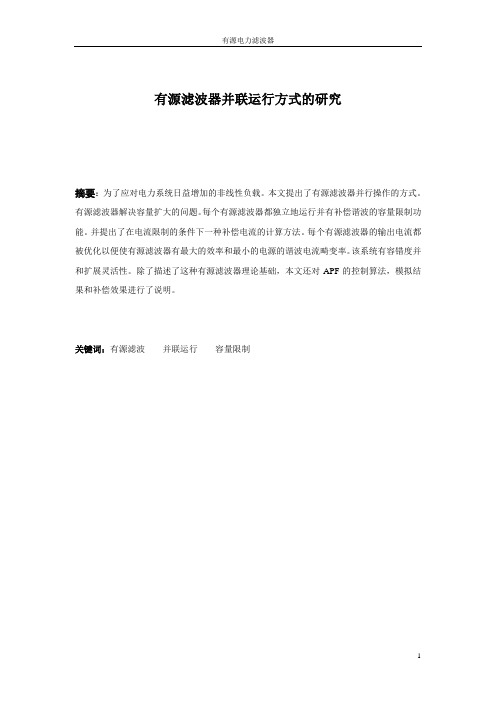
有源滤波器并联运行方式的研究摘要:为了应对电力系统日益增加的非线性负载。
本文提出了有源滤波器并行操作的方式。
有源滤波器解决容量扩大的问题。
每个有源滤波器都独立地运行并有补偿谐波的容量限制功能。
并提出了在电流限制的条件下一种补偿电流的计算方法。
每个有源滤波器的输出电流都被优化以便使有源滤波器有最大的效率和最小的电源的谐波电流畸变率。
该系统有容错度并和扩展灵活性。
除了描述了这种有源滤波器理论基础,本文还对APF的控制算法,模拟结果和补偿效果进行了说明。
关键词:有源滤波并联运行容量限制一、简介谐波污染被视为一个降低电能质量主要问题,特别是配电系统的谐波共振的可能会导致连续不稳定的过电压和电流波形畸变和电器元件不正常运行或损坏。
无源滤波器对系统阻抗和负荷特性十分敏感。
该无源滤波器串联和并联谐振问题是几乎不可能得到解决。
有源电力滤波器已成为一个在电力工程领域的热门话题。
在过去20年中,有源电力滤波器已发展到抑制谐波产生的静态功率转换器。
不同的有源电力滤波器串联和并联的连接方法被提出目的是解决谐波成分所造成的问题。
但是仍然存在着一个重要的问题需要解决。
因为需要处理日益增加的非线性负载,有源滤波器容量增加的是必不可少的。
为了解决有源滤波器的扩展问题,本文提出了一种适合于有源电力滤波器并联运行方式。
这种方法解决了容量扩大的问题,每个有源滤波器都独立地运行并有补偿谐波的容量限制功能。
参考文献[ 2 ] [ 3 ]有源滤波器没有高效率,每个有源滤波器的输出电流都被优化以便使有源滤波器有最大的效率和最小的电源的谐波电流畸变率。
该系统有容错度并和扩展灵活性。
二、源滤波器并行操作的方式图1(a)中央控制方式(b)分布控制方式(c)主从控制方式A中央控制方式连接的方式如图。
为了多个电流控制逆变器使用,需要计算补偿电流,由控制器分发给各种逆变器的电流控制中心产生逆变器电流命令。
好处是,主要电路组成的多路增加开关频率以及满足容量的能力。
用于有源电力滤波器的谐波检测技术英文文献
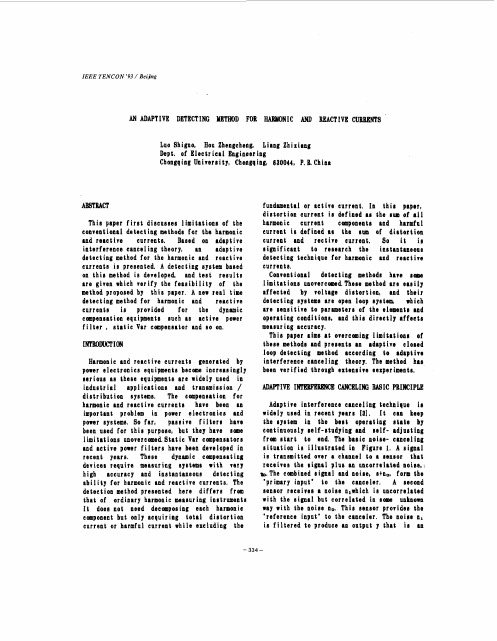
ADAPTIVE E 1
CANCELING BASIC PEINCIPLE
Adaptire interference canceling technique ir widely used in recent years [31. It can keep the system in the best operating state by continuously self-studying and self- adjusting from start to end. The basic noise- canceling situation i6 illustrated in Figure 1. A signal is transmitted over a channel to a sensor that receives the signal plus an uncorrelated noise, I %.The combined signal and noise, stno, form the 'primary input' to the canceler. A second sensor receives a noise n,whlch is uncorrelated with the signal but correlated in BOW) unknown ray with the noise no. This sensor provides the "reference input" to the canceler. The noise nl is filtered to produce an output y that is an
fundamental or active current. In this paper, distortion current is defined as the sum of all harmon ic current components and harmful current is defined as the sun of distortion current and rective current. So it is signif icant to research the instantaneous detecting technique for harmonic and reactive currents. Conventional detecting methods hare s m limitations unovercomsd. These method are easily affected by voltage distortion, and their detecting systems are open loop system, which are sensitive to parameters of the elements and operating conditions, and this directly affects measur ing accuracy. This paper aims at overcoming limitations of these methods and presents an adaptive closed loop detecting method according to adaptive interference canceling theory. The method has been ver if ied through extensive eexper iments.
有源电力滤波器综述

第38卷2010年8月云 南 电 力 技 术YUNNAN ELECTR I C POWER Vo l 38N o 4Aug 2010收稿日期:2010-06-15有源电力滤波器综述雷 鹏 刘柱揆 覃日升(云南电力试验研究院(集团)有限公司电力研究院,云南 昆明 650217)摘要:文中根据有源电力滤波器补偿系统的功率等级和响应速度、根据主电路的电路结构和连接方式、根据补偿变量三个方面对有源电力滤波器进行分类,并阐述各种有源电力滤波器的特点。
关键词:有源电力滤波器 电能质量 分类中图分类号:TM5 文献标识码:B 文章编号:1006-7345(2010)04-0043-041 前 言有源电力滤波器(A ctive Po w er F ilter ,APF)是改善和提高电能质量的有效手段之一,将APF 运用于电力系统,其补偿非线性负载产生的谐波和无功功率,从而使得电网电流波形保持正弦,有效提高电网的电能质量。
目前,有很多种方法对APF 进行分类,其中,可以根据补偿系统的功率等级和响应速度、根据主电路的电路结构和连接方式、根据补偿变量对APF 进行分类。
2 APF 分类方法2 1 根据功率等级和响应速度分类为了实现相应的补偿功能,补偿系统的功率等级和响应速度决定了APF 的控制策略。
功率等级与响应速度之间有着密切的相互联系。
通常,响应速度越快系统花费的成本越高,见图1。
图1 AP F 根据功率等级和响应速度的分类图2 1 1 低功率等级应用功率低于100kVA 的系统属于低功率等级应用,使用范围主要包括民用住宅、商业大楼、医院、小规模到中等规模的工业负载和驱动系统。
这些系统通常采用技术比较复杂的动态有源滤波器,尤其是多脉冲P WM 电压源逆变器或电流源逆变器系统,其响应时间比较短,系统的补偿功率也比较小。
1)单相有源电力滤波器主要运用于低功率等级场合,如:计算机负荷较多的商业大楼、教学大楼、小规模工业等。
- 1、下载文档前请自行甄别文档内容的完整性,平台不提供额外的编辑、内容补充、找答案等附加服务。
- 2、"仅部分预览"的文档,不可在线预览部分如存在完整性等问题,可反馈申请退款(可完整预览的文档不适用该条件!)。
- 3、如文档侵犯您的权益,请联系客服反馈,我们会尽快为您处理(人工客服工作时间:9:00-18:30)。
重庆科技学院学生毕业设计(论文)文献综述题目有源电力滤波器技术院(系)电子信息学院专业班级自普本05学生姓名金涛学号2005441140 指导教师(签字)有源滤波技术文献综述摘要:随着各种功率器件的广泛应用,大量的谐波和无功电流注入电网,引起电网污染,造成电网电能质量问题日益严重但电力电子装置自身所具有的非线性也使得电网的电压和电流发生畸变。
过去,国内外大量采用无源滤波装置来进行谐波抑制和无功补偿,提高功率因数。
但无源滤波装置也存在着自身无法克服的不足和缺陷,有源电力滤波器由于具有高度可控性和快速响应性,能对频率和幅值都变化的谐波进行跟踪补偿,因而受到广泛的重视,成为目前国内外供电系统谐波抑制研究的热点。
关键词:有源电力滤波器逆变器1 引言随着电力电子技术的飞速发展,越来越多的电力电子装置被广泛应用到各个领域,近年来配电网中整流器、变频调速装置、电弧炉等非线性负荷不断增加,这些负荷的非线性、冲击性和不平衡的用特性,使电网中暂态冲击、无功功率、高次谐波及三相不平衡问题日趋严重,对公用电网的供电质量造成了严重影响,因此,消除电网中的谐波污染已成为电能质量研究中的一个重要课题。
有源电力滤波器(APF)是一种消除电网谐波的有效装置,具有高度可控和快速响应的特性,它不仅能补偿各次谐波,还可抑制闪变、补偿无功,有一机多能的特点。
其滤波特性不受系统阻抗的影响,同时还具有自我适应功能,可自动跟踪补偿变化的谐波。
有源滤波技术现状有源电力滤波器的基本工作原理是由HSasaki和HMachida于1971年首先提出的[1]。
他们首次提出了有源滤波器的原始结构模型,并建立了有源滤波器的基本理论。
他们提出的有源电力滤波器向电网注入一个与负载谐波电流幅值相等、相位相反的电流,从而抵消了电网中的谐波电流。
但由于当时是采用线性放大的方法产生小补偿电流,其损耗大,成本高,因而仅在实验室研究,未能在工业中实用。
1976年,LGyugyi和ECStyaula提出了用PWM逆变器构成的有源电力滤波器[2]。
这些采用PWM逆变器构成的有源电力滤波电路现已成为有源电力滤波器的基本结构。
20世纪80年代,随着电力电子技术和PWM控制技术的发展,对有源电力滤波器的研究逐渐活跃起来,成为电力电子技术领域的研究热点之一。
1983年赤木泰文等人提出的“三相电路瞬时无功功率理论”[3]极大的推动了有源电力滤波器的发展及其工程应用。
在国外,有源电力滤波器已开始在工业和民用设备上得到广泛使用,并且谐波补偿的次数逐步提高,有的可以高达25次谐波;单机装置的容量逐步提高。
如在日本和美国,应用领域可以接受的APF的容量已增加到50MVA,其应用领域从补偿用户自身的谐波向改善整个电力系统供电质量的方向发展。
我国在有源电力滤波器的应用研究方面,继日本、美国、德国等之后,得到学术界和企业界的充分重视,并投入了大量的人力和物力,到目前为止,国内对有源电力滤波器的研究基本上都局限于仿真研究和小型试验装置,工程实践应用仅仅也只是小功率的应用[4,5],而正式投入电网运行的几乎为零[6]总的来说,国内有源电力滤波器的应用技术和电子工业发达的国家相比有一定的差距。
最早的有源电力滤波器是单独使用的并联型有源电力滤波器,经过多年的发展,为了尽量发挥有源电力滤波器的特长,提高其性能并尽量降低其容量,结合无源电力滤波器的特点发展成了串联混合型有源电力滤波器、并联混合型有源电力滤波器等等,为了适应不同的补偿对象,发展了各种各样的有源滤波器形式。
根据有源滤波器和电网的连接方式,APF可以分为并联型和串联型两大类。
1986年Akagi H.提出了并联型APF单独使用方式[3],它是最早期的有源滤波装置。
图1.1 单独使用的并联型APF这种方式的主电路结构简单,但由于逆变器直接承受基波电压,所以其成本高且不适合高电压系统的补偿。
为降低成本、减小逆变器的容量和适应高电压的要求,人们利用PF 的成本低的优点,提出了各种APF与PF混合使用方式。
1987年Takeda M.等人提出用并联型APF和并联PF相结合的混合型APF[7]。
图1.2 并联型APF+并联PF的HAPF该方式利用无源部分滤除了大部分的谐波,所以其有源部分的谐波容量较小,且PF能够提供一定的无功功率,但逆变器仍然直接承受了基波电压,所以功率开关器件的耐压等级并没有降低。
1990年Fujita H.等人提出将APF与PF相串联后与电网并联的混合型方案[8]。
图1.3 APF与PF串联后并联接入电网的HAPF这种方式利用无源部分承受了大部分的基波电压,所以逆变器承受的基波电压小,适合于高电压系统的应用。
但由于流过无源部分的基波电流都流入逆变器,所以不能利用PF 提供大容量的无功功率。
利用无源元件LC的串、并联谐振特性,人们提出了注入式APF的结构[9,10]。
将LC对基波串联谐振电路作为有源部分的注入电路,能够大大降低APF承受的基波电压和容量,且可以利用无源元件提供无功功率,但其谐波容量相对较大,而且所能提供的无功容量有限。
随着电力电子技术的发展,全控型功率开关器件(如可关断晶闸管GTO和绝缘栅双极性晶体管IGBT)的电压和电流额定值不断提高,成本不断降低,人们从双或多逆变器的方向提出了各种APF的拓扑结构,来满足工业应用的要求。
1994年,Akagi H.等提出一种将串联型APF和并联型APF进行混合的方式,也称为统一电能质量调节器(Unified Power Quality Conditioner,UPQC)[11]。
图1.4 并联型APF+串联型APF的HAPF这种方式从理论上讲,可以抑制电压闪变、电压波动、不对称和谐波,但由于采用了双逆变器,所以存在控制复杂和成本高的缺点。
上述描述了并联型APF的发展现状,有源滤波器还有另外一大类——串联型APF,图1.5为典型的串连APF拓扑结构[12]。
图1.5 单独使用的串联型APF串联型APF单独使用方式能有效滤除电网的谐波电压,具有有源装置容量小和运行效率高等优点,但存在绝缘强度高、难以适应线路故障条件以及不能进行无功功率动态补偿等缺点,且负载的基波电流全都流过连接用的变压器,其工程实用性受到限制。
在串联型APF单独使用方式基础上发展出的串联型APF混合型结构[13,14],也都同样存在绝缘强度高和难以适应线路故障的缺点总结与展望本论文立足于有源电力滤波器的工业应用,对有源电力滤波器控制器的硬件模块构成、软件实现方法进行了详细的探讨当然,随着先进工业技术的发展,有源滤波器无论从设计上,还是从控制上都会不断得到提高,本文也只是有源电力滤波器技术研究的局部结合论文完成过程中遇到的困难以及实际工程实践中积累的经验,个人认为还有必要进行以下几方面的深入研究:(1)控制器的快速响应及装置的兼容性(2)降低有源滤波器的开关损耗(3)抑制有源滤波器的电磁干扰(4)进一步提高有源电力滤波器的可靠性参考文献[1]Sasaki H, Machida T. A New Method to Eliminate AC Harmonic Currents byMagnetic Compensation Consideration on Basic Design. IEEE Trans. on PAS, 1971, 90(5):2009-2019[2]Gyugyi L, Strycula E C. Active AC Power Filters. In: Proceedings ofIEEE/IAS Annual Meeting, 1976: 529-535[3]Akagi H,Kanazawa Y,Nabae A. Generalized theory of the instantaneousreactive power in three-phase circuits. In: IEEE & JIEE. Proceedingd IPEC.Tokyo: IEEE 1983.[4]陈国柱, 吕征宇, 钱照明. 50kVA变频调速器谐波的混合有源滤波. 电气传动, 2002年第3期:31~35[5]卓放, 杨君, 胡君飞, 王兆安. 30KVA并联型有源电力滤波器装置的研制.电工技术杂志, 2000.4:13~15[6]陶骏. HT-7U高功率电源系统无功功率补偿与谐波抑制的研究. 中科院等离子体物理所博士学位论文.[7]M. Takeda, K. Ikeda, and Y. Tominaga, Harmonic Current Compensation withan Active Filter, in Conf. Rec. of IEEE-IAS, 1987, pp. 808~815.[8]Fujita H, Akagi H. A Practical Approach to Harmonic Compensation in PowerSystems-Series Connection of Passive and Active Filters. In: IEEE IAS Annual Meeting Conference Record, 1990: 1107~1112[9]Atosuo N, Kiyoshi O. Active filter with series resonant circuit. IEEE PESC 88Record, APRIL 1988:1168~1175.[10]Noriaki T, Yoshiya O. Active Filter with Series LC Circuit. Proceedings ofIEEE ICHPS VI, Bologna, 1994[11]Akagi H, et al. A New Power Line Conditioner for Harmonic Compensation inPower Systems. IEEE Trans. on PWRD, 1995, 10 (3): 1570~1575[12]Peng F Z, Akagi H, Nabae A. A New Approach to Harmonic Compensation inPower System. In: IEEE IAS Conference Record, 1988. 874~880[13]Peng F Z, Akagi H, Nabae A. A New Approach to Harmonic Compensation inPower System-A Combined System of Shunt Passive and Series Active Filters.IEEE Trans. on IA, 1990, 26 (6): 983~990[14]Peng F Z, Lai J S. Application Considerations and CompensationCharacteristics of Shunt Active and Series Active Filters in Power Systems.Proceedings of IEEE ICHQP VII, Las Vegas, NV, 1996。
